With a population of just under 700,000, you may be surprised to find out just how many amazing attractions there are in Seville. I would dare to say that there are far more things to do in Seville than in many cities in Spain, including Barcelona and Madrid and I always look forward to returning. Part of that reason could be because of Seville’s history.
Located in the southern region of Spain in Andalusia, this beautiful Spanish City was an important hub during the rule of the Muslim Moors and then later, once the New World was discovered, it played a direct role in commerce. This allowed the city to become even richer and has left us with some amazing monuments.
Table of Contents
Best Things to Do in Seville
Over the past few years, more and more people have been finding out what all of the fuss is about in Seville. The city is seeing a large increase in visitors and prices have been soaring. But, there is so much to see and thankfully, a lot of things to do in Seville are free! Here is my list of thins to do in Seville with many being free things to help you save money.
Planning Your Trip To Seville Right Now?
These are the top tours and activities in Seville. Don’t forget to plan ahead when visiting Seville!
Train travel is one of the best ways to get around Europe. Check out Omio for prices for train travel to Florence.
Top Seville Tourist Attractions and Tours:
- Private one-way airport or train transfer to your hotel (Best Deal)
- Alcazar Skip the Line and Guided Tour (Highly Rated)
- Seville Cathedral and Alcazar guided tour Combo – (Likely to Sell Out)
This post was originally written by Patricia Palacios, information has been updated by The Planet D team for 2023 travel to Seville.
Plaza de España
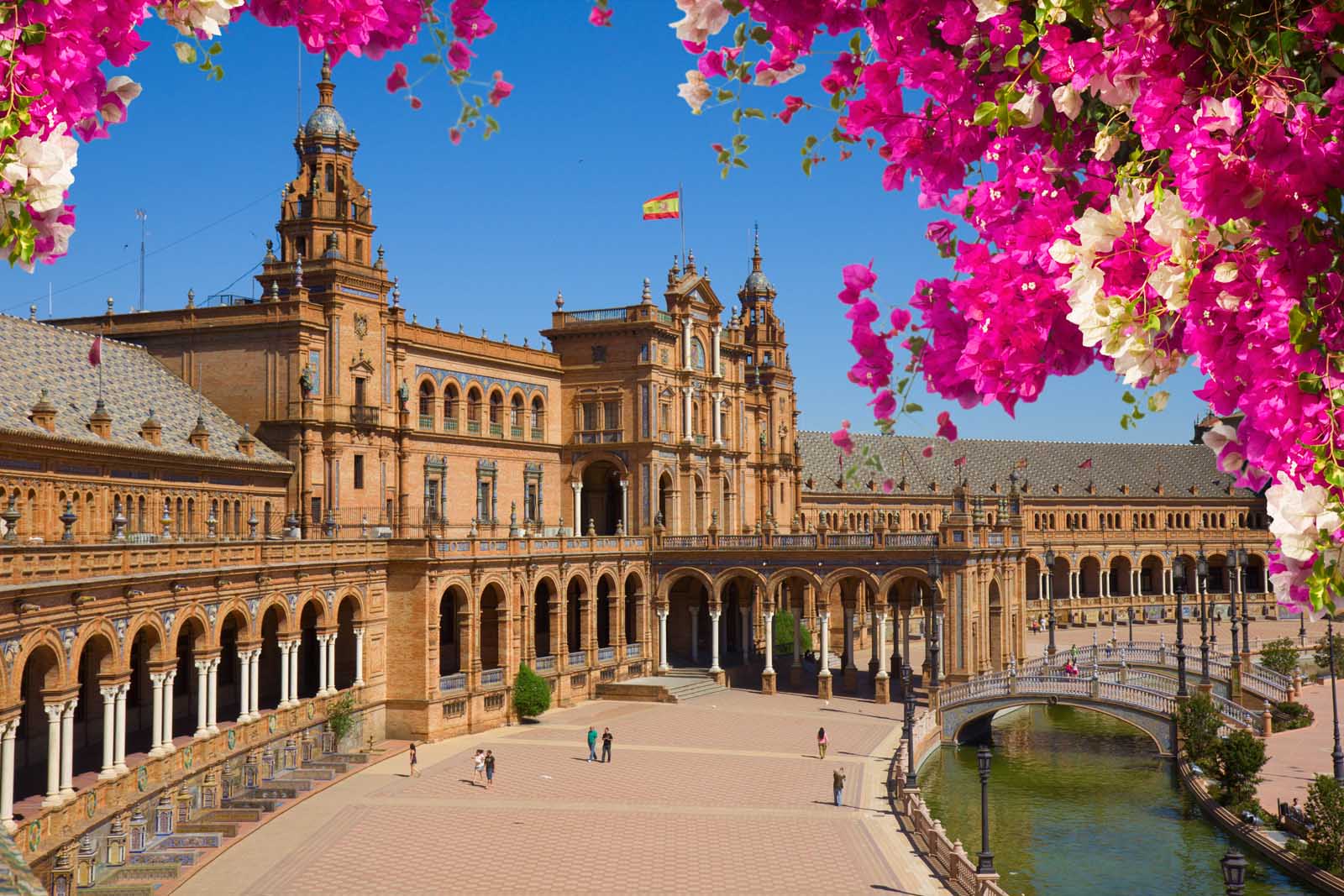
No trip to Seville would be complete without a visit to the Plaza de España. This square has become a symbol of the city, and the best part is, it’s completely free. Situated in the heart of Maria Luisa Park, the Plaza de España is a semi-circular brick building, Renaissance/neo-Moorish in style, and serves as one of Seville’s most iconic landmarks.
The massive U-shaped building feels completely Andalusian. Plaza de España combines a long history of local styles – Baroque, Renaissance, and Mudejar – into one unique creation. Its bridges represent the four ancient kingdoms of Spain and the canals in front give it the nickname ‘Venice of Seville’.
Tourists flock here to admire its intricate tilework which represents different provinces of Spain.
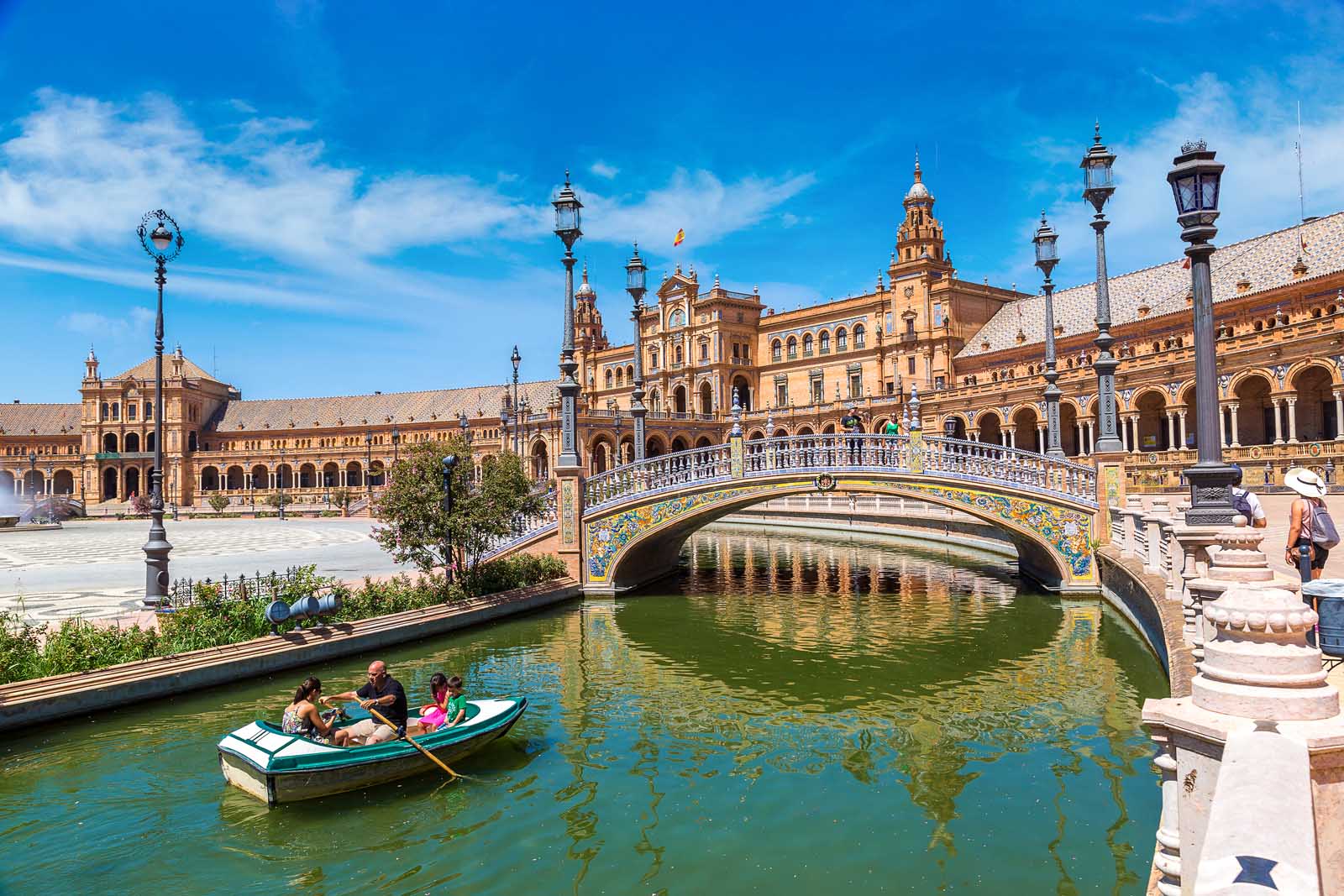
If you haven’t been to Seville but recognize the plaza, it might be because you have seen it on the big screen. Star Wars: Episode II – Attack of the Clones and Lawrence of Arabia were all filmed here.
There’s a lot to explore and check out in the square. Simply exploring the square is one of the top free things to do in Seville. You’ll need about 5 minutes just to cross from one side to the other! Taking a boat ride or simply walking around, you’re bound to be enchanted.
If you have a few bucks to spend, you can try your hand at rowing a boat around the square’s moat or sit back and relax in a horse drawn carriage driven by an Andalusian thoroughbred horse. Details here.
Parque de María Luisa (Maria Luisa Park)
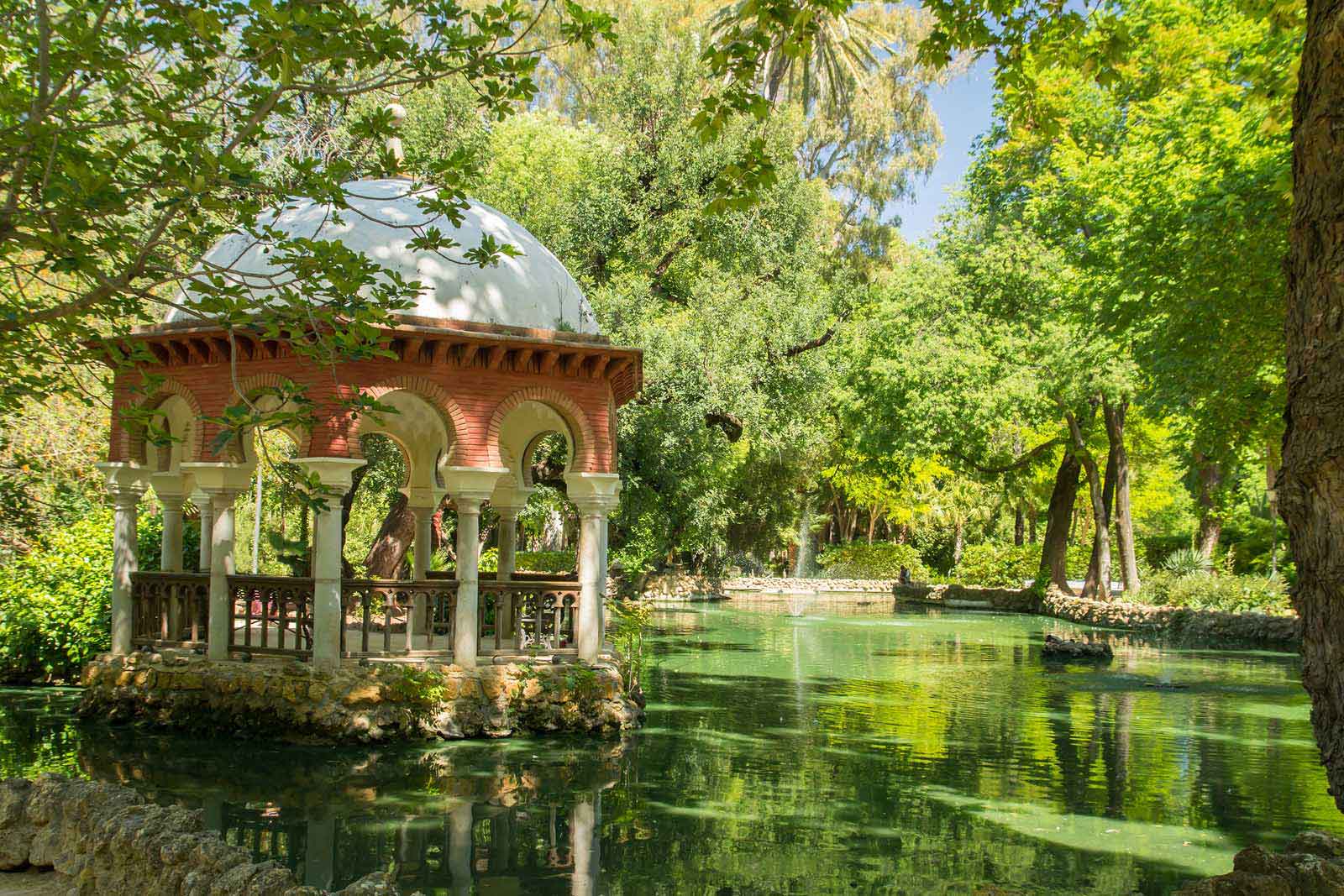
To say Maria Luisa is just a park would be an understatement. It is more like a botanical garden that has ponds with fountains surrounded by lush palm forests, orange trees, and all kinds of colorful flowers.
The park, along with several other buildings found within its borders, were all constructed for the Ibero-American World Fair in 1929. Today, many of them have been turned into museums. There are even parakeets living in the park as well as ducks and swans.
Originally a private garden of the San Telmo Palace, Parque de María Luisa became public in the late 19th century and was designed in a manner to showcase Andalusian charm. Fountains, ponds, and local birds add to its beauty, making it perfect for leisurely strolls.
Casa de Pilatos
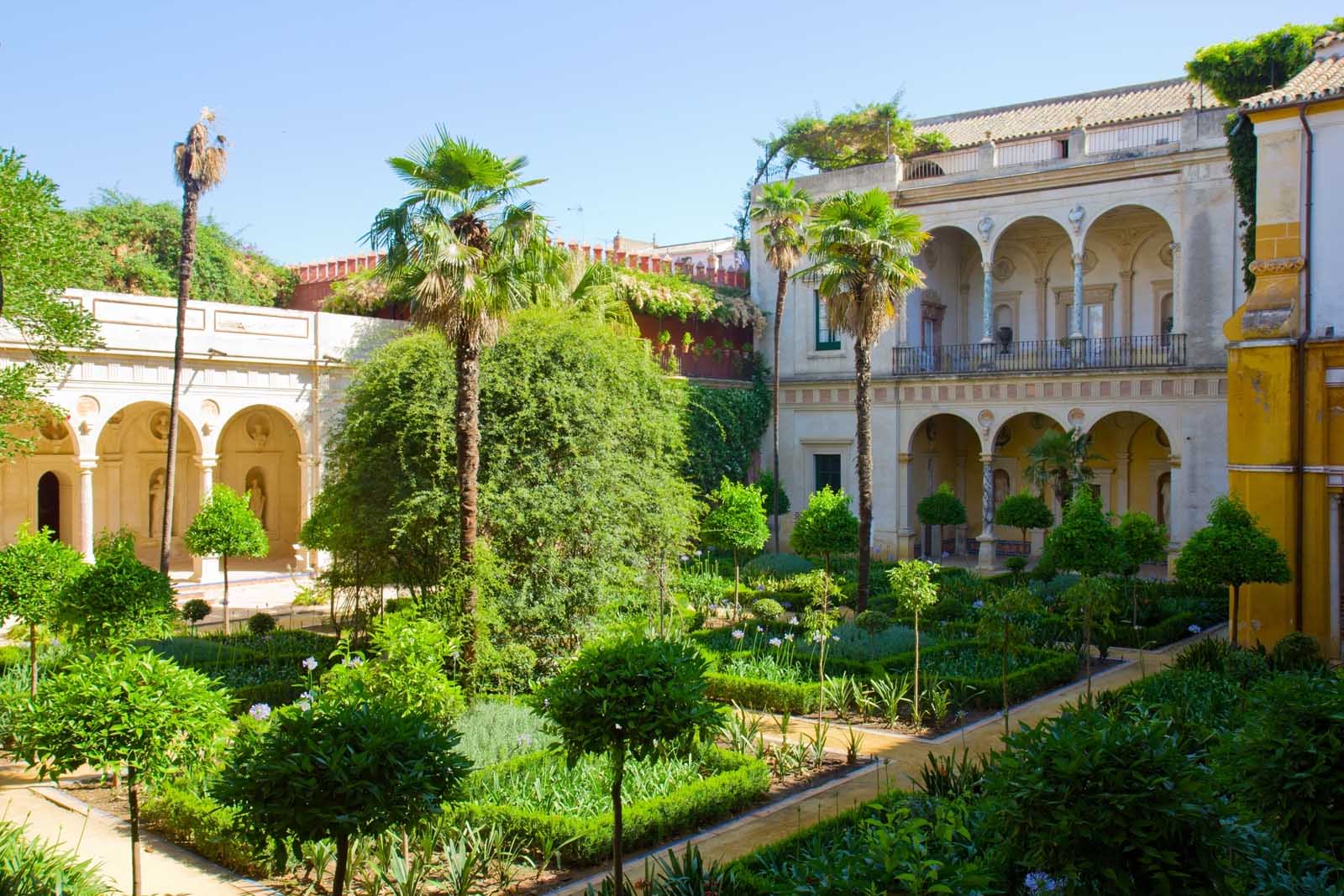
Tucked away in the old quarter, Casa de Pilatos amalgamates various architectural styles including Gothic, Renaissance, and Mudejar, showcasing the rich history of Seville. Its captivating courtyards and gardens make it a serene escape. The blend of cultures and epochs becomes evident as you wander through, from its Roman sculptures to its azulejos (ceramic tiles) that depict myriad stories.
Purchase your ground floor entry ticket to see its impressive designs owned by the Enríquez de Ribera family in the 15th century. It was teh biggest private residence in Seville. There are fountains and sculptures of Roman emperors, and Gods and goddesses.
Real Alcazar Palace (Royal Alcazar Palace)
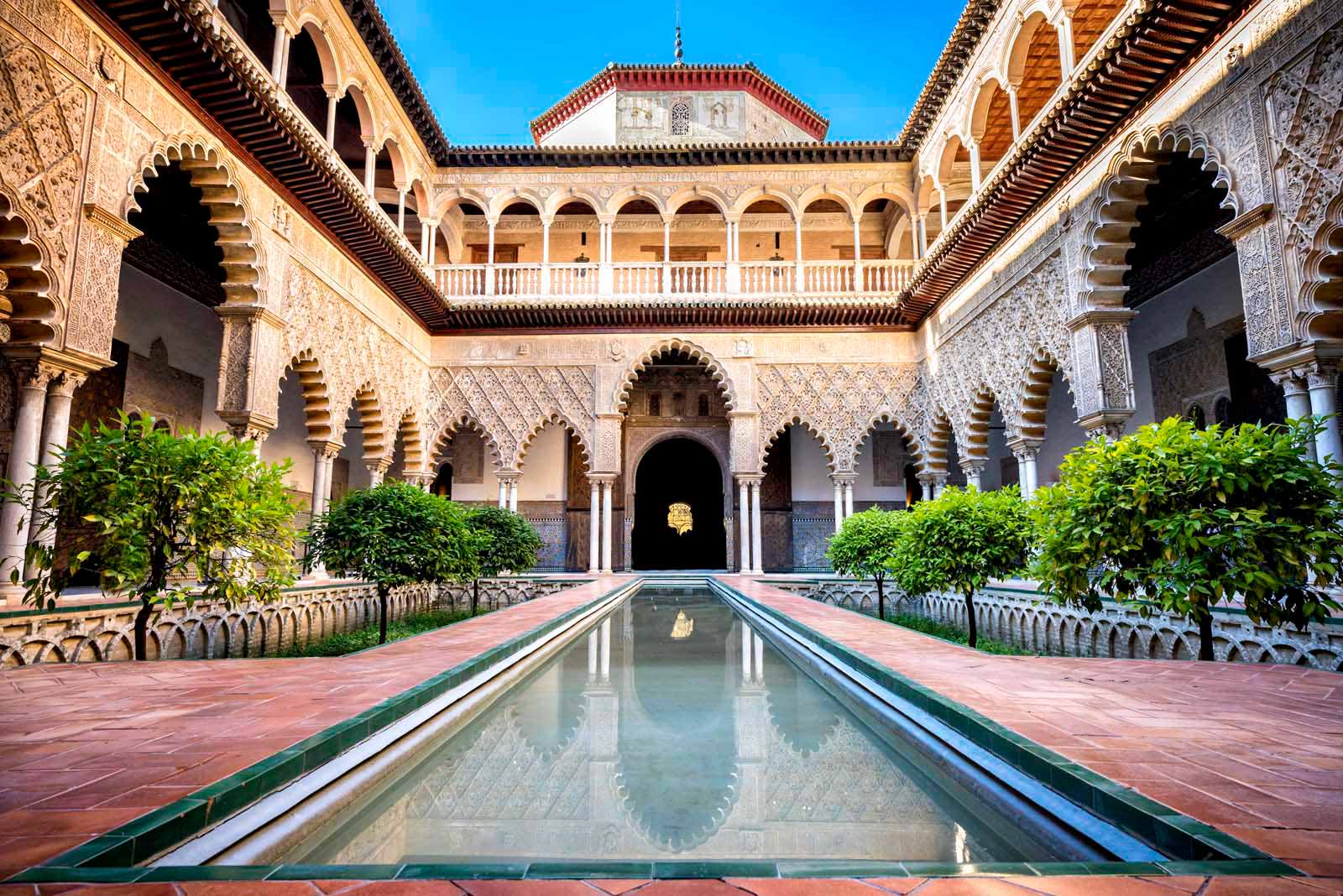
Real Alcazar Palace boasts stunning Mudejar architecture. The UNESCO World Heritage site is replete with ornate tiles, intricate arches, and sprawling gardens. Even today it is still used by the Spanish Royal family. It is a living museum where history merges seamlessly with the present.
The Real Alcazar Palace is an expansive complex of palaces, gardens, and fortresses that stands as a testament to the multicultural history of the region. The origins of Real Alcazar date back to the 10th century when the Moors established the region as a fortress for the Muslim governors and has seen many reiterations over the centuries.
When the Christian Reconquista took Seville in 1248, the Real Alcazar underwent an extensive renovation of the palace, leading to the creation of the Mudejar Palace, a fusion of Gothic architecture from the Christians and the Moorish Mudejar style.
The Real Royal Alcazar Palace is more than just a historical monument; it’s a living tapestry of the cultures, art forms, and Spanish history that helped shaped Andalusia. A visit here is not just a tour but a journey through time, offering a deep dive into the soul of Seville.
Game of Thrones fans will want to visit Real Alcazar as it was one of the filming locations in the TV series representing Water Gardens of Dorne. Read more: Game of Thrones Filming Locations You Can Visit in Real Life
Palacio de las Dueñas
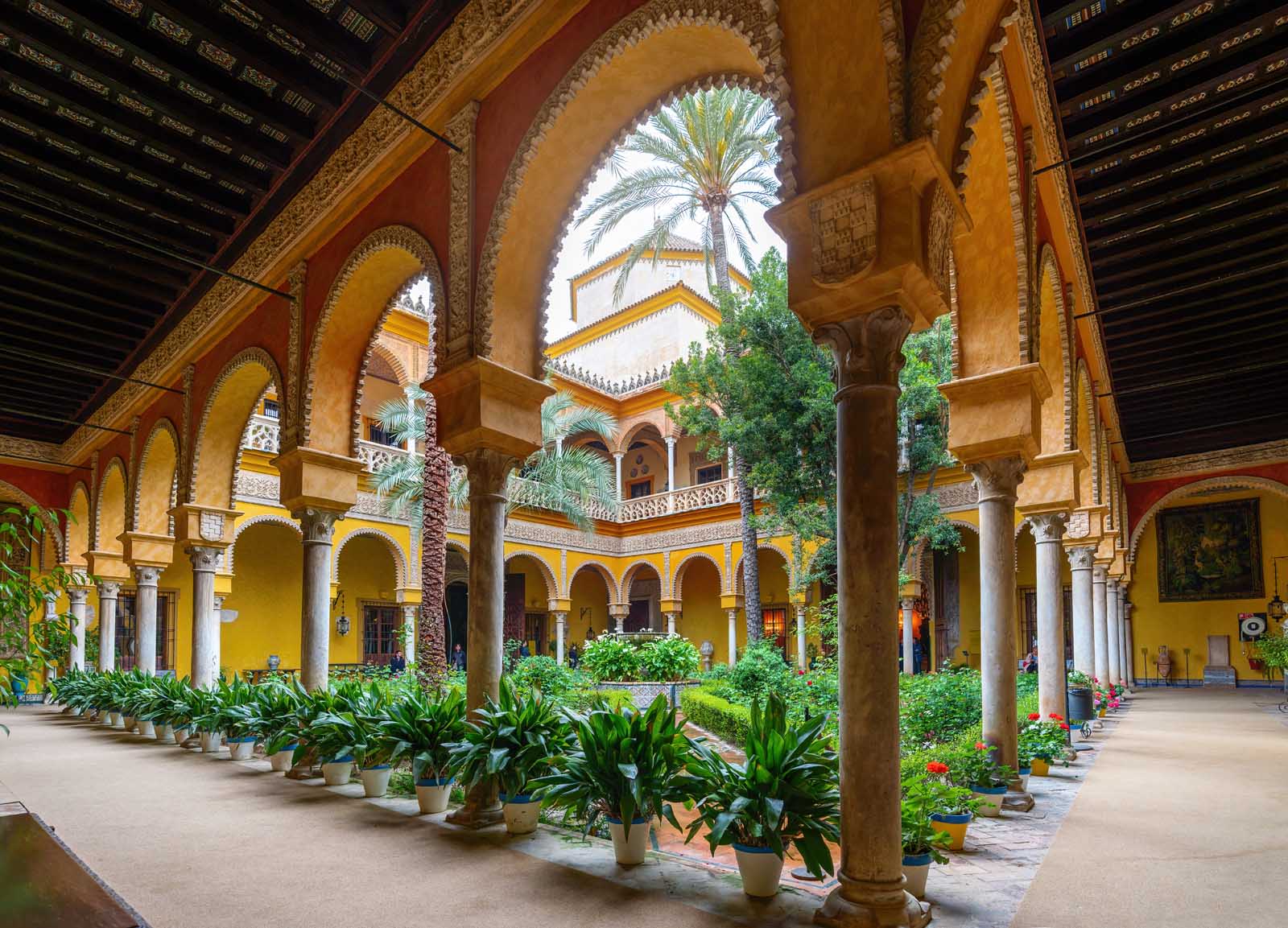
This 15th-century palace is a tapestry of Gothic, Mudejar, Renaissance, and Romantic styles. It was the birthplace of Antonio Machado, one of Spain’s greatest poets.
Palacio de las Dueñas is one of Seville’s greatest historical attractions. Visitors can explore its courtyards, gardens, and majestic rooms by wandering its halls. Palacio de las Dueñas also has a diverse collection of art.
Get your ticket with audio guide to learn about the palace’s history as you stroll the halls. This palace has seen many visitors from Queen Victoria to Jackie Kennedy.
Visitors are captivated by the courtyards of Palacio de las Dueñas dotted with orange trees and its fascinating azulejos. Palacio de las Dueñas is a journey through time, providing a nuanced look at Seville’s aristocratic history.
Sevilla Cathedral (Seville Cathedral)
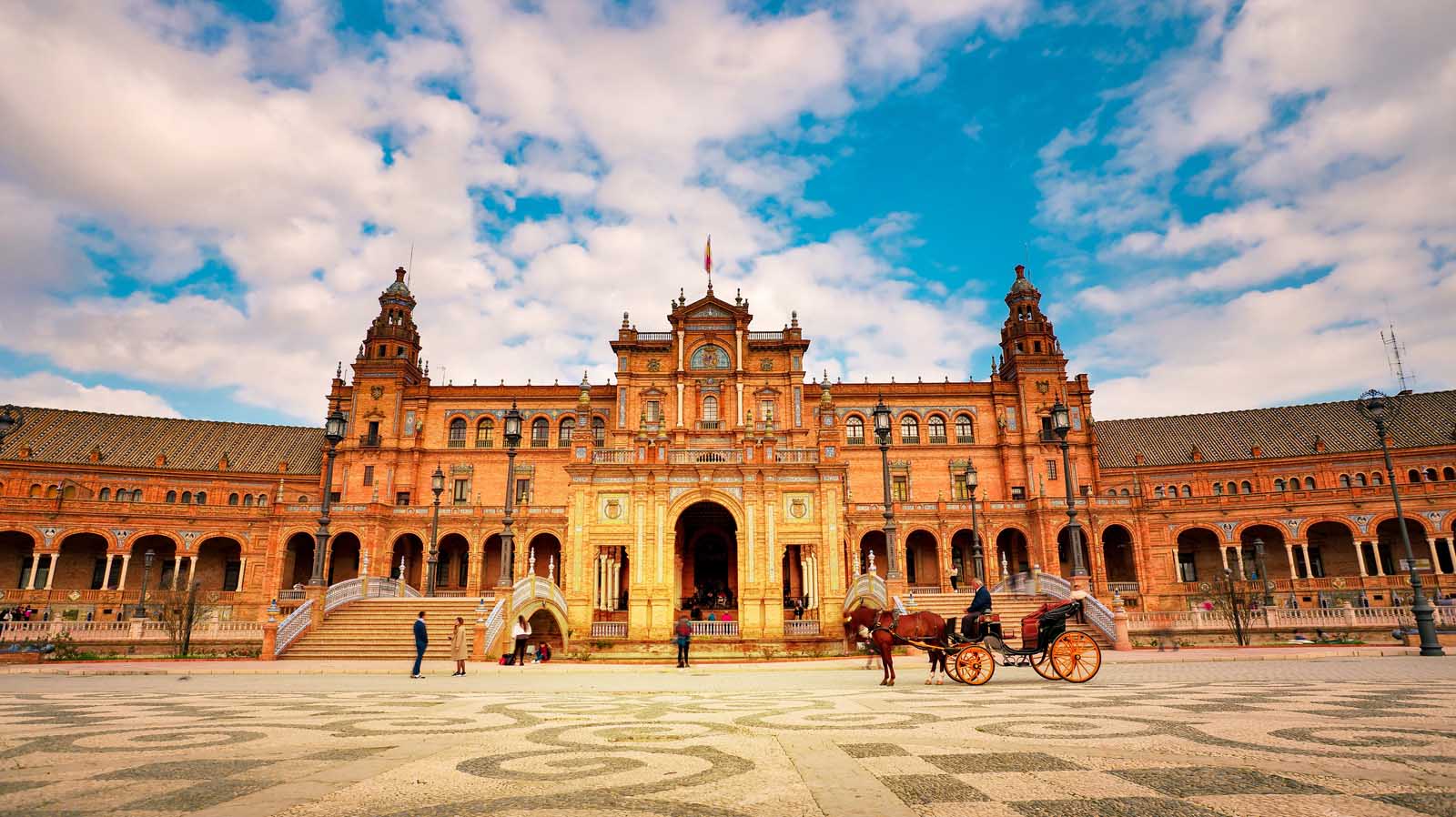
An architectural marvel, the Seville Cathedral stands as the largest Gothic cathedral in the world. The Seville Cathedral and its La Giralda Tower are a UNESCO World Heritage Site and it is one of the top attractions in the city. The soaring bell tower, La Giralda Tower, offers an unparalleled view of the city.
The UNESCO World Heritage Site attracts visitors from around the world who are awed by the magnificent altarpiece, detailed stained glass windows, and the vast collection of art. Every corner whispers tales of devotion, artistry, and grandeur.
One Monday Afternoons you can enter the biggest Gothic Church in the world for free. Seville’s number one tourist attractions usually have an entrance fee of €9, but on Mondays between 4:00 and 5:30 you can visit for free if you book in advance online here. Tickets give you access to the Cathedral and La Giralda.
La Giralda Views
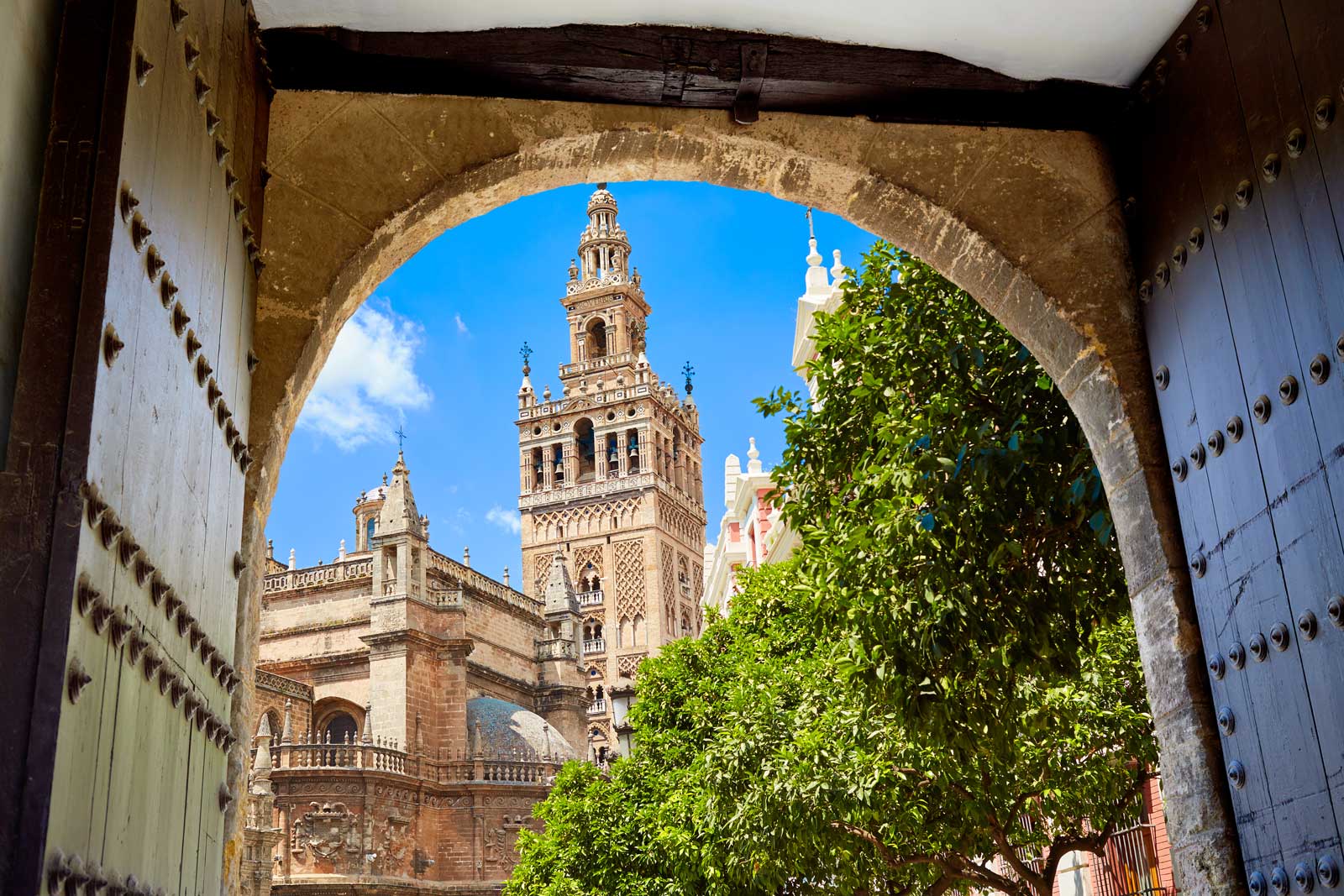
Once you are finished touring, make your way to the Patio de Los Naranjos and enjoy the shade of orange trees as you look up at La Giralda bell tower.
This Seville Cathedra tour includes La Giralda and Royal Alcazar Palace complex with skip-the-lie tickets. Visit the Cathedral’s interior and visit the Morrish La Giralda Bell Tower. The Palace was the setting for the film Lawrence of Arabia and Game of Thrones.
Tomb of Christopher Columbus
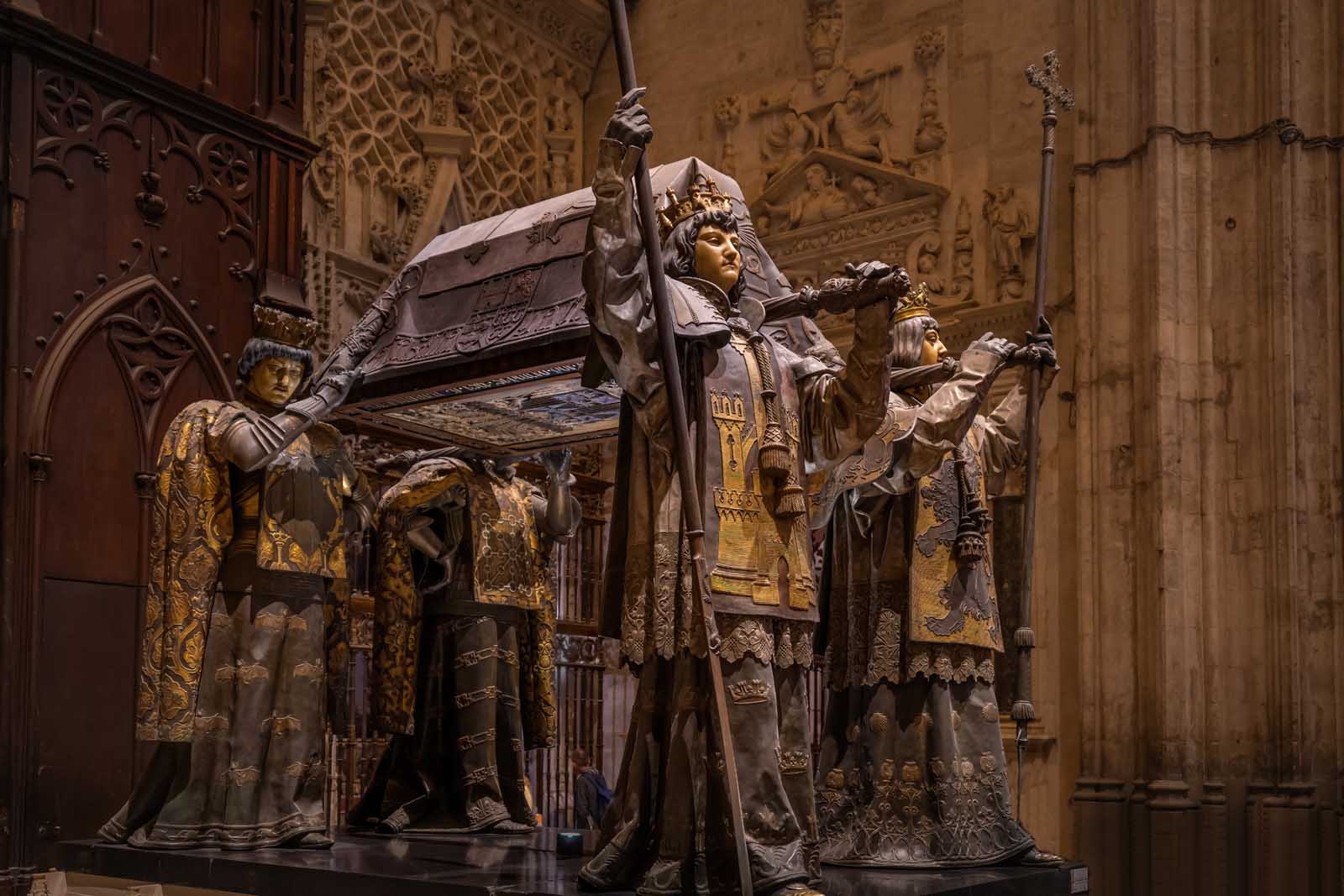
Located within the magnificent Seville Cathedral, the Tomb of Christopher Columbus is one of the most iconic and debated resting places in the world. It stands as a monument not only to the famed explorer but also as a reflection of Spain’s tumultuous and expansive history during the Age of Exploration.
The tomb itself is an imposing and grand structure, held aloft by four statues representing the four kingdoms of Spain during Columbus’s life: Castile, León, Aragón, and Navarra.
Mystery of Columbus
For years, there has been debate about whether the remains inside truly belong to Columbus. After his death in 1506, Columbus’s body went on a transatlantic journey of its own. Initially buried in Valladolid, Spain, his remains were later moved to a monastery in Seville. In accordance with his will, his bones were then transported to the New World, to Santo Domingo in present-day Dominican Republic. Years later, when the French took over, his remains were moved to Havana, Cuba, and then back to Seville when Spain lost Cuba in the Spanish-American War. However, a box with bones and Columbus’s name was discovered in Santo Domingo in the late 19th century, sparking the debate.
Climb Metropol Parasol
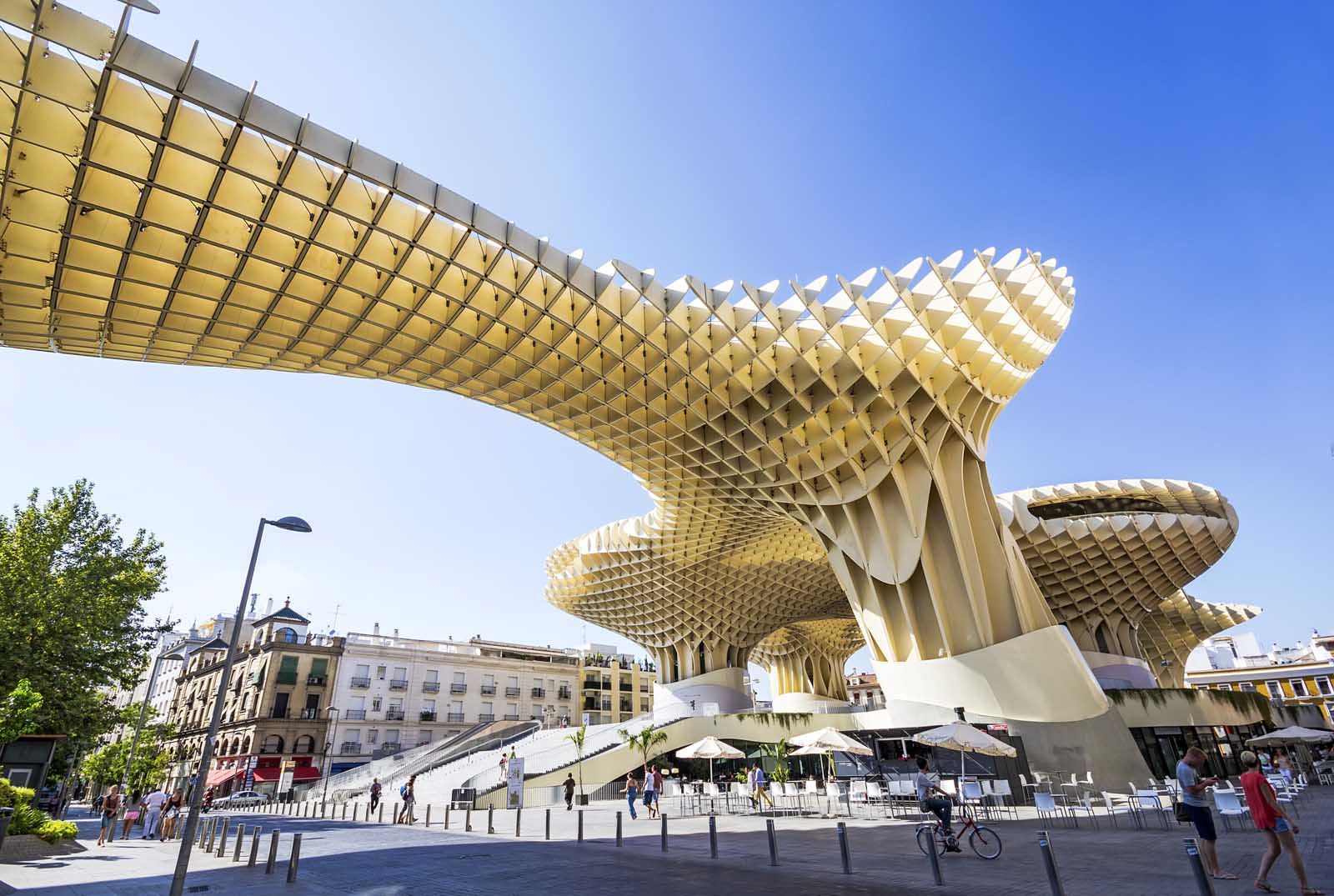
The crazy geometric Metropol Parasol (popularly known as The Mushroom) is an eye catching structure that hovers over La Plaza de la Encarnación (Encarnation Square). Designed by a German architect and completed in 2011, it has since become one of Seville’s most interesting sights.
Surprisingly, most of the Metropol Parasol is made from wood and it’s actually considered to be the world’s largest wooden structure. Known locally as “Las Setas” (The Mushrooms), Metropol Parasol is a modern architectural wonder in the heart of historic Seville.
This wooden structure offers shade, a market, and an elevated plaza. The panoramic terrace atop provides a 360-degree view of the city, juxtaposing the new with the old.
Viewing the Metropol Parasol from the square is of course one of the most popular free things to do in Seville. But if you feel inclined, for 5€ (10€ in the evenings) you can take an elevator to the top and walk around a ramp that has some of the best views of Seville.
Antiquarium
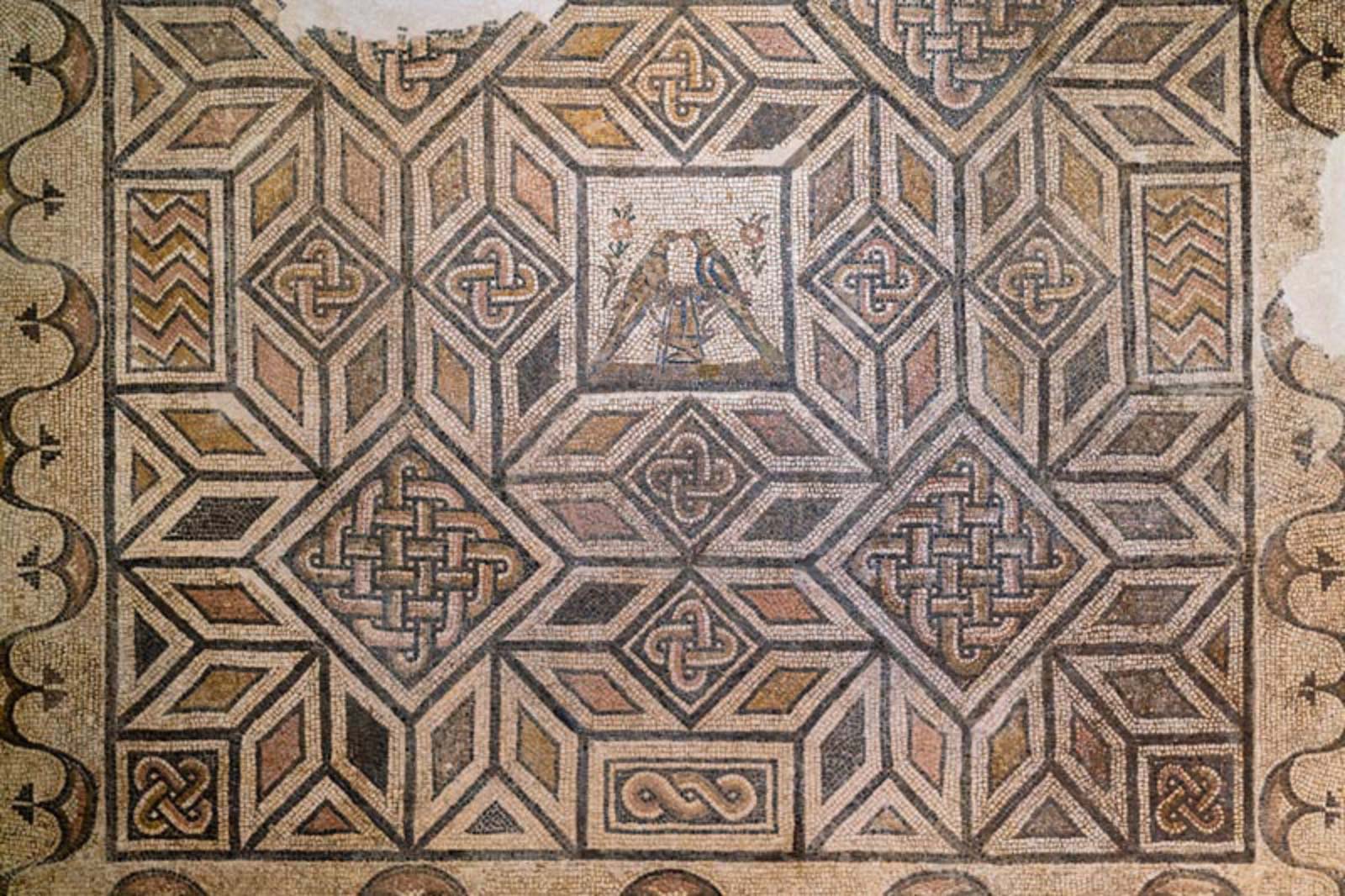
Below ground at the Metrosol Parasol, is a Roman archeology site that has building foundations and several mosaics. The ruins were discovered when workers were digging to build a car-park under the square. Needless to say, the car-park had to be moved!
While entrance to the Antiquarium normally costs 2.1€, you can get in for free if you have your ticket from the Alcazar. Everyone should visit the Palacio de Alcazar in Seville because it is so incredible. So just make sure to make it to the Antiquarium on the same day.
Beneath the modern structure of Metropol Parasol lies the Antiquarium, a well-preserved Roman and Moorish archaeological site. The museum offers a unique subterranean journey through Seville’s ancient past, showcasing remains of Roman streets, homes, and mosaics. Interactive exhibits and thoughtful design make it an immersive experience, transporting visitors back in time.
Take a Boat Tour
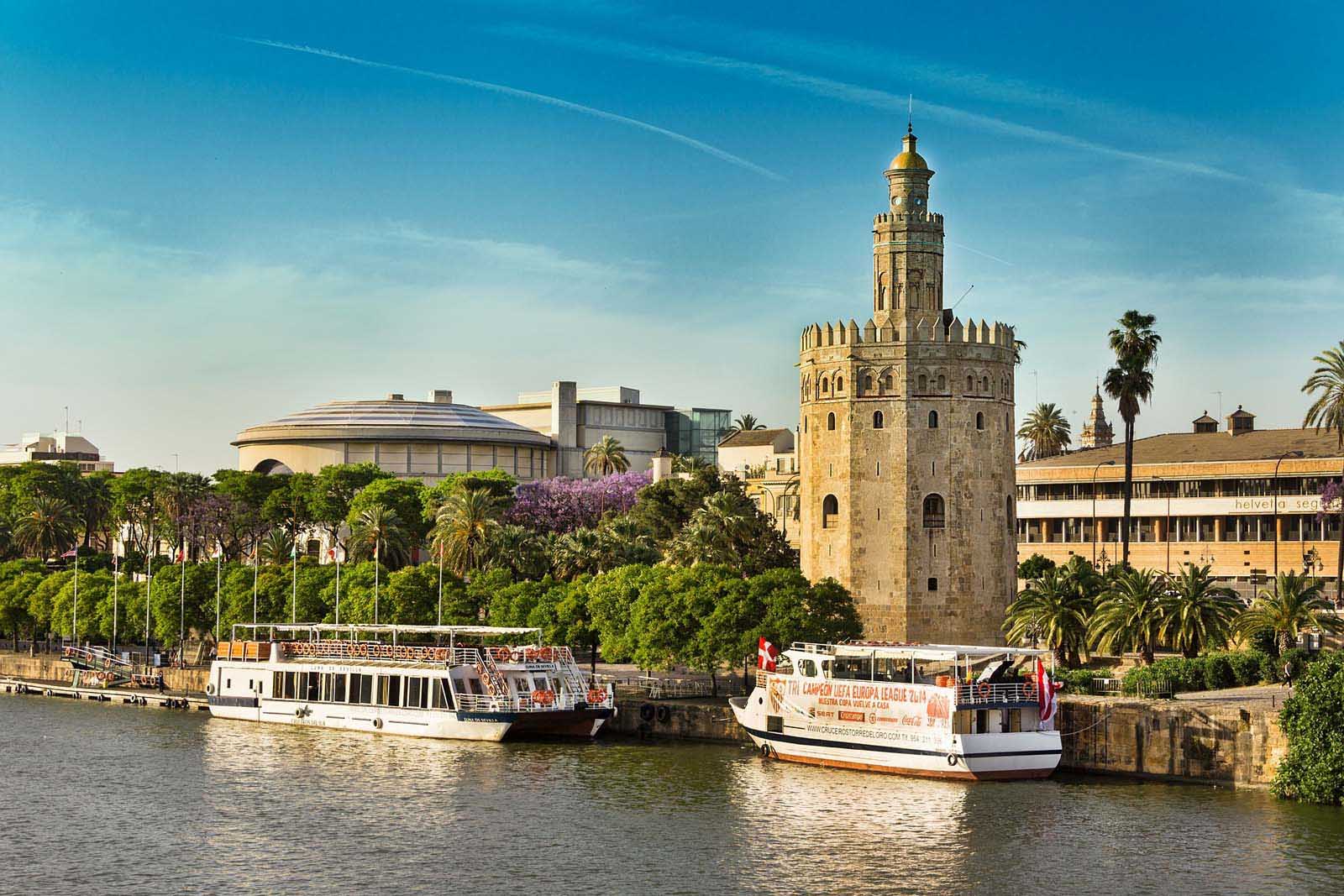
One of the best things to do in Seville is to hop aboard a boat cruise on the Guadalquivir River. You’ll get to see the newest parts of the city and La Cartuja Island before continuing to the historic part of Seville. Sights you will see are Plaza de España, the oldest iron bridges in Europe – the Isabel Bridge II (popularly known as Triana Bridge) the Plaza de Toros de La Maestranza, Torre del Oro, Palacio de San Telmo, and more.
A boat tour is a great introduction to Seville and its top attractions. Plus, you’ll enjoy a sangria, beer or non alcoholic drink while enjoying tapas on board. See more details about a boat tour of Seville here.
Iglesia Colegial del Salvador
This baroque church, second only to the Seville Cathedral in size, is a masterpiece with its ornate altars and intricate wooden carvings. Once a mosque, its Islamic roots are evident in the underlying architectural nuances. A visit here is a confluence of faith, history, and art.
Plaza de Toros
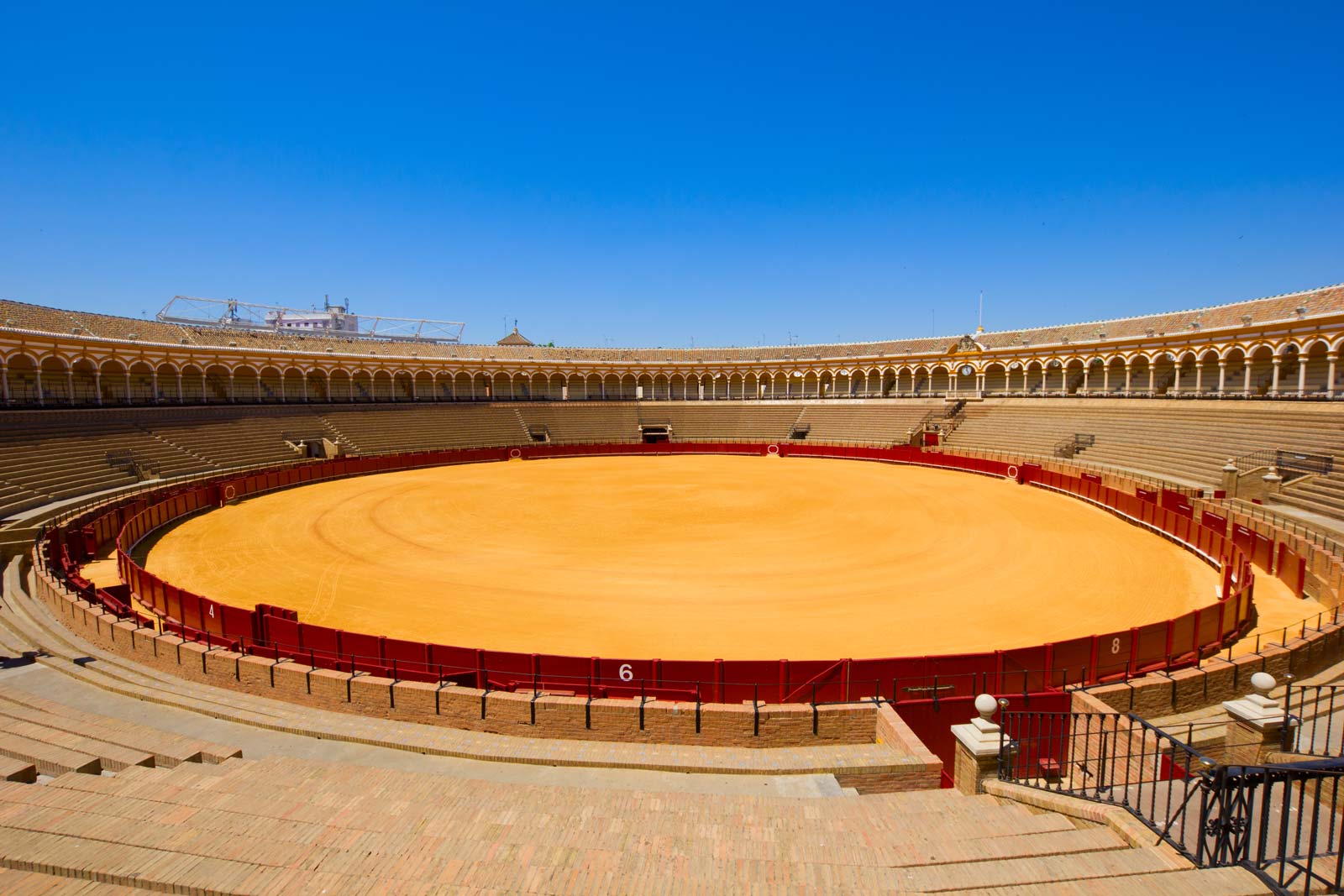
As one of the oldest bullrings in Spain, Plaza de Toros is more than just a venue for bullfighting; it’s a symbol of Spanish culture and tradition. No matter what your opinion is on bullfighting, it has been a part of Spain’s culture since the 1700s. With its Baroque facade and rich history dating back to the 18th century, it offers visitors a deeper understanding of the age-old tradition, controversies, and the art of matadors.
Triana Neighborhood
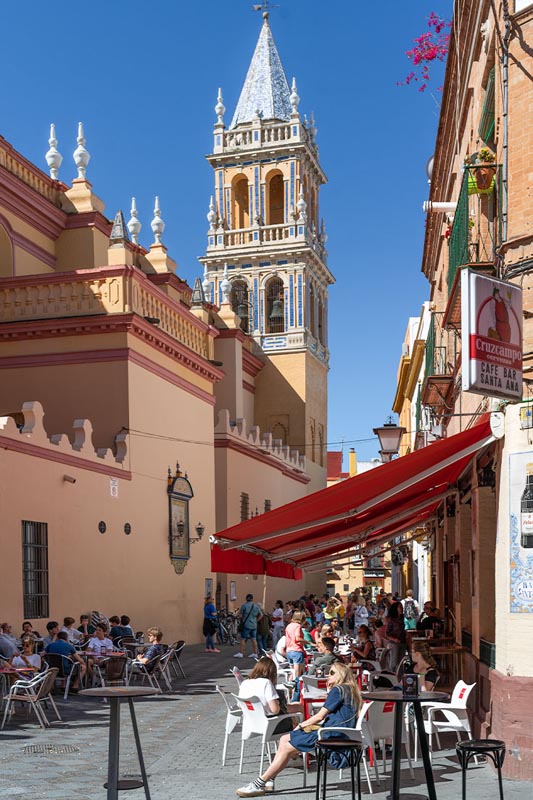
Triana is one of only a handful of neighborhoods found on the east side of the river. But it’s Seville’s most colorful and charismatic barrio. The residents are proud of Triana’s heritage and usually will identify first as Trianeros and then as Sevillanos.
Triana has a long history of pottery, tile making, and music. This is where flamenco has its strongest roots within the city. As you explore this area, especially in the summer, it’s not uncommon to hear the stomping of feet or flamenco guitars pouring out of the windows.
Spanish Inquisition Museum
While in Triana, visit the Free Museo Del Castillo, San Jose. It was the first seat of the Spanish Inquisition and traces the cruelty and torture of Spain’s dark past.
Even if you don’t want to see the museums themselves, you should at least go to admire the architecture from the outside. For example, the Museum of Arts and Traditions of Seville, is one of the most impressive Mudejar style buildings in the city.
If you are visiting Seville in the summer then you will know that the middle of the day can be brutal. The temperature can easily climb to over 100 ºF (40 ºC). When it’s that hot, the park is a great place to go. The temps under the tree canopy are much cooler than in the concrete jungle of the city. Just don’t forget a bottle of water!
General Archive of the Indies (Archivo de Indias)
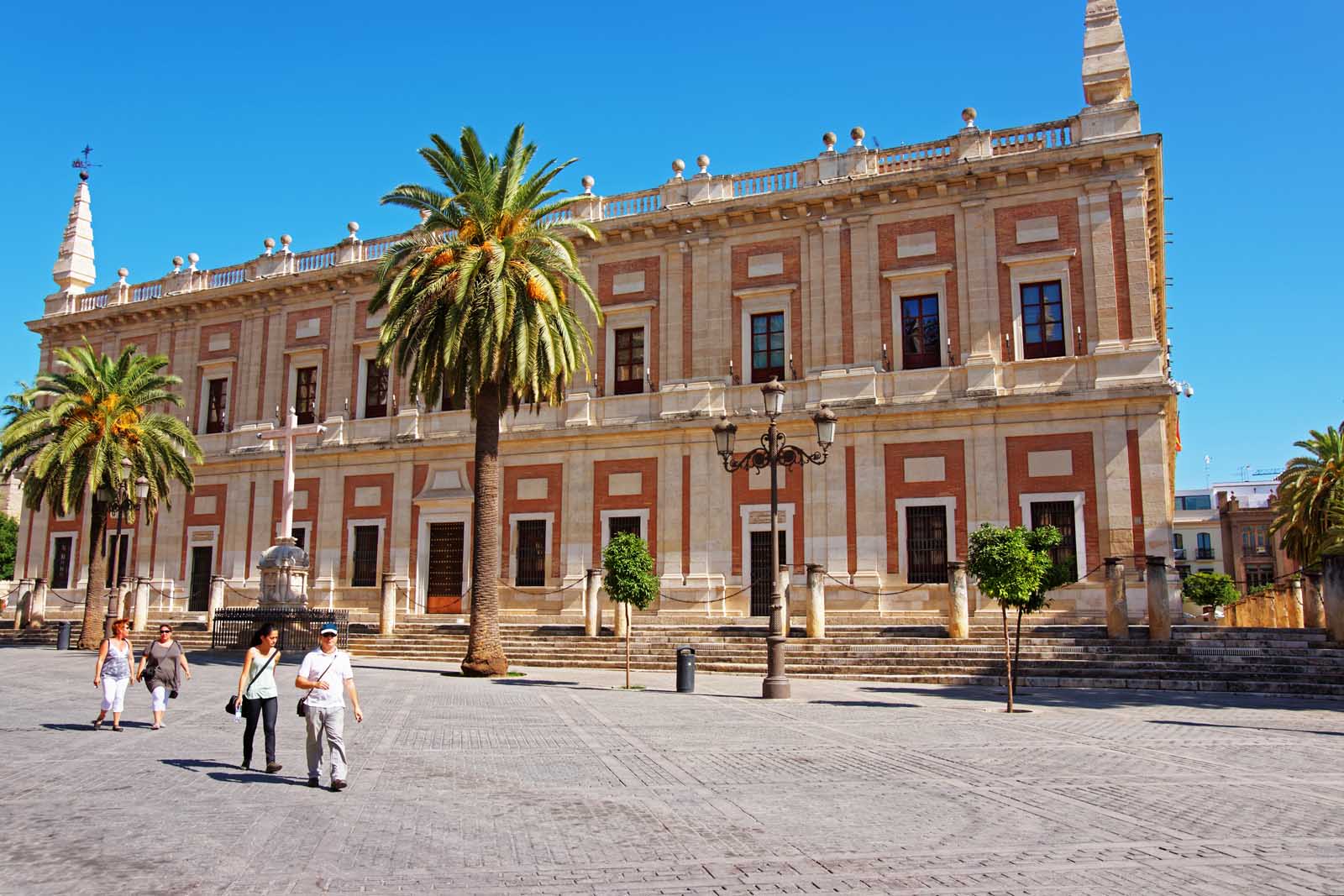
The General Archive of the Indies was built in 1572 and functioned as a merchant exchange for all the goods and riches from the New World. It houses documents from the first conquistadors and continues all the way through the end of the 1800’s.
Needless to say, this building contains lots of important history and as such, it was declared a Unesco World Heritage Site. Its grand rooms look like something from a Harry Potter film. The endless corridors are lined with archives that are stacked to the ceiling. The General Archive is conveniently located next to the Alcazar and the cathedral and doesn’t take too much time to go through.
Housed in a Renaissance building, the Archive safeguards an invaluable collection of documents depicting the history of the Spanish Empire in the Americas and the Philippines. Recognized as a UNESCO World Heritage Site, this establishment serves as a research hub for historians and offers an in-depth look into Spain’s colonial ventures. Plus it’s completely free, so there is no reason not to check it out.
Hospital de los Venerables
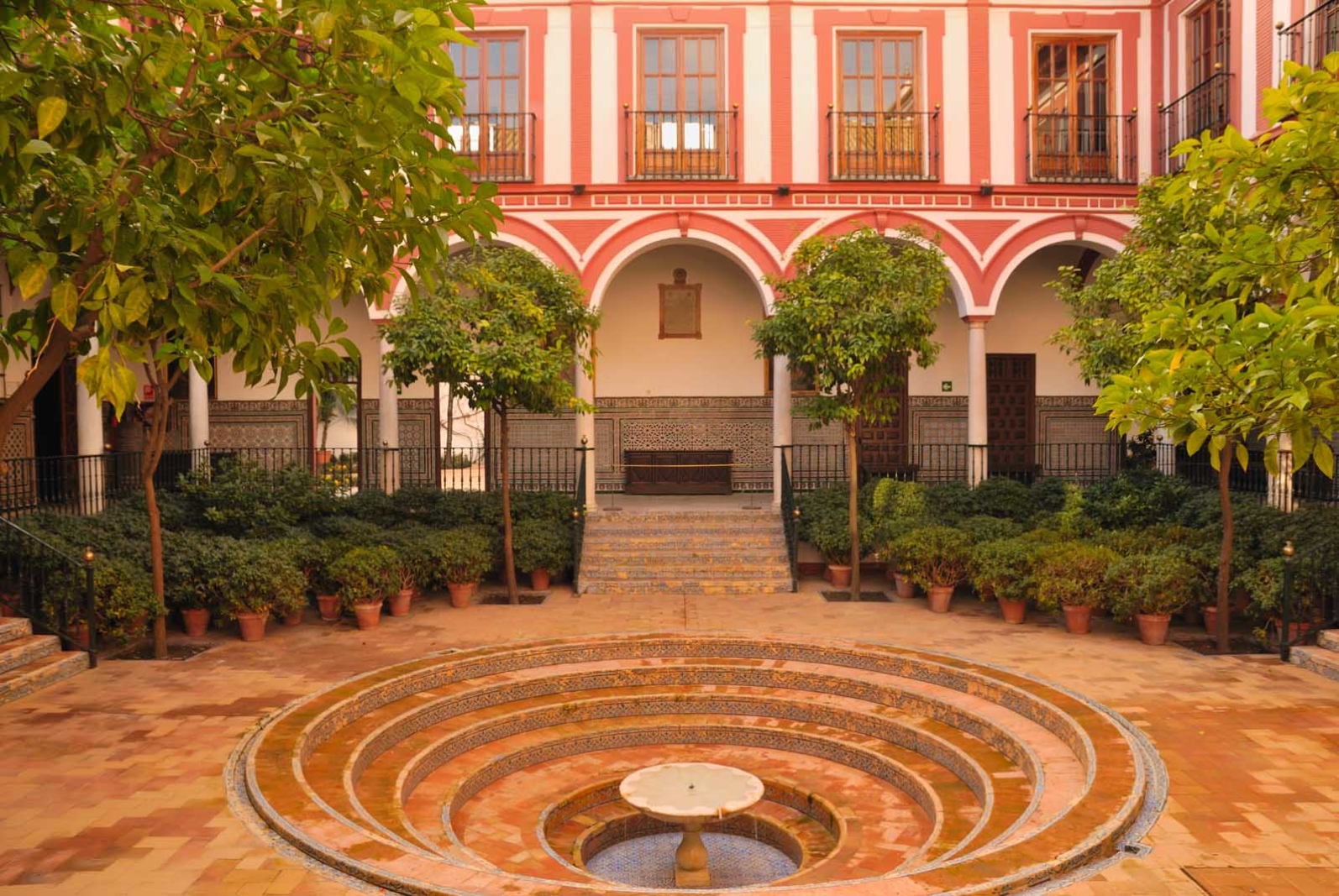
This 17th-century baroque building, once a residence for priests, is a serene oasis in the bustling heart of Seville. With its sun-drenched courtyards and stunning baroque church, the complex is a testament to Seville’s commitment to preserving its architectural treasures. It currently serves as a cultural center and often hosts contemporary art exhibitions.
Basílica de la Macarena
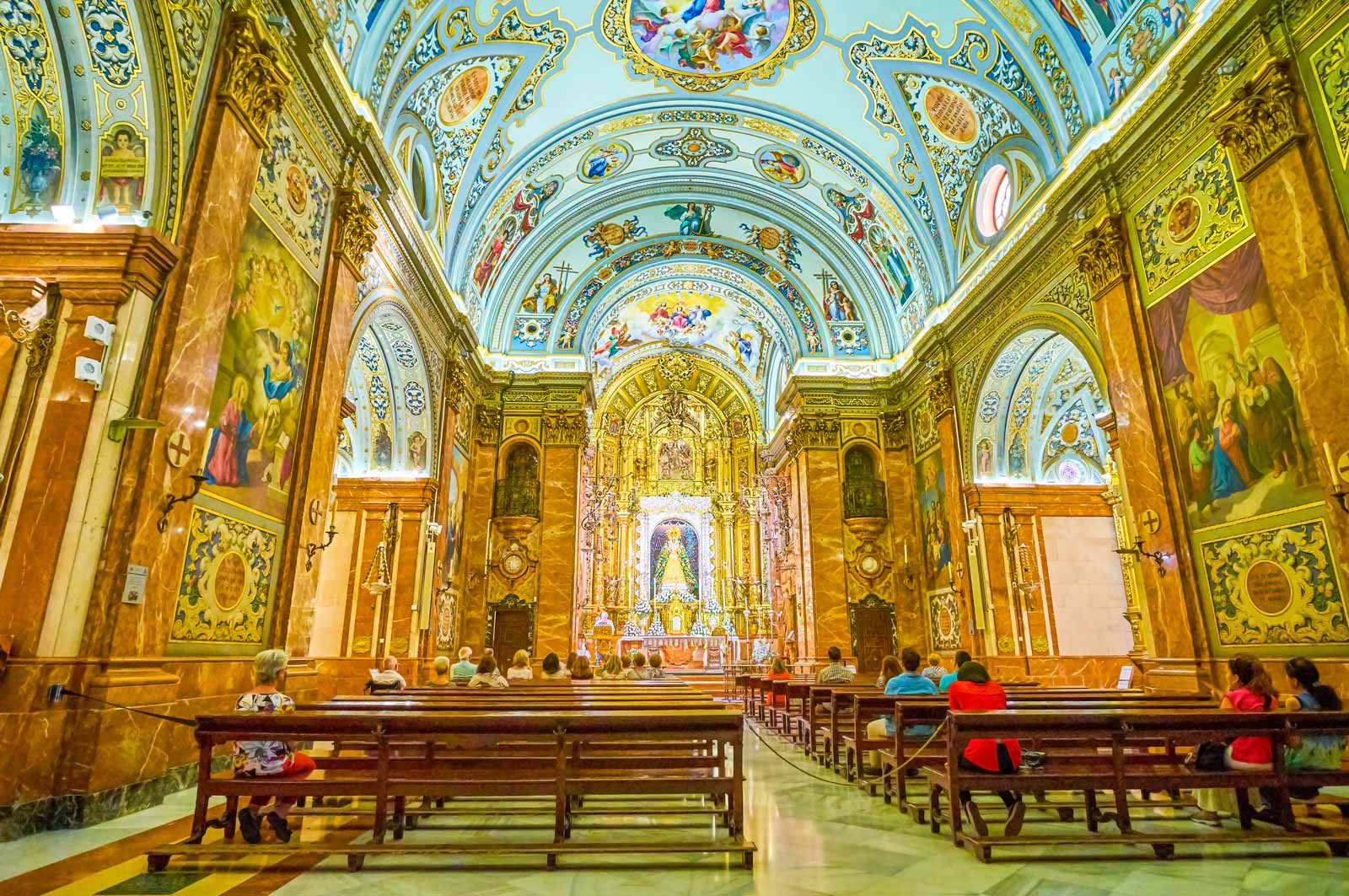
This basilica is located on the outskirts of Seville and from the outside it seems rather simple. But step inside and you will be shocked by its flamboyant styling. This church holds two of the most important religious floats that are used in the city’s legendary Easter processions. If you want to learn more about Seville’s Holy Week (Semana Santa), then check out the church’s museum. It costs 5€. Entrance to the church is free.
Home to the revered Virgin of Macarena, this basilica draws both pilgrims and art enthusiasts. The golden altar and the treasured statue of the Virgin, often adorned with flowers, make it a beacon of devotion in Seville. The adjoining museum showcases the rich history of the Holy Week processions. Located in the Macarena district, this basilica is a beacon of religious fervor. I
Torre del Oro
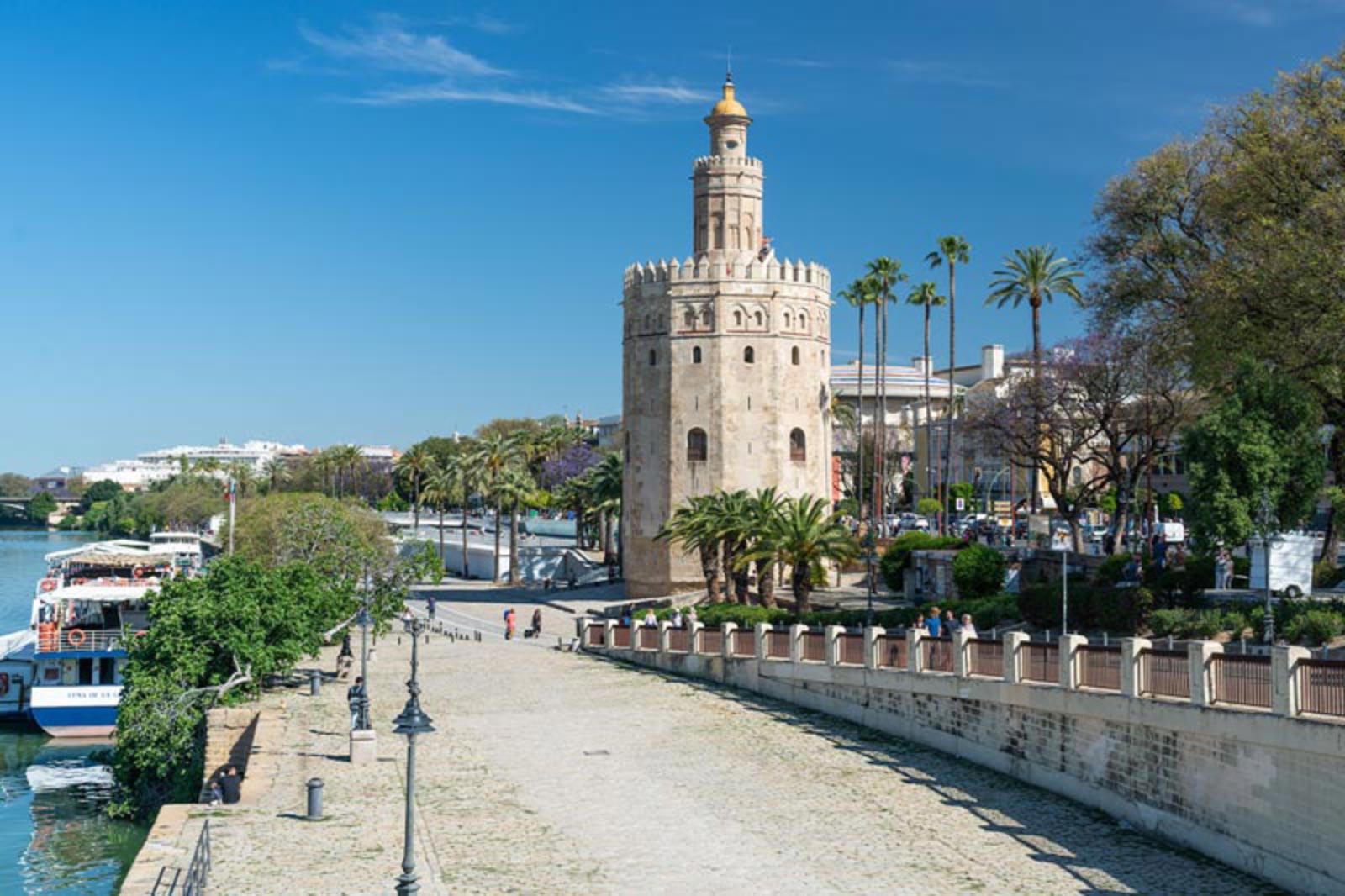
Torre del Oro (Tower of Gold) is one of the best places to take in the views of the Triana neighborhood, with all its colorful buildings lined up in front of the calm water. Make sure to check out the Torre del Oro (Tower of Gold), famous for having housed many of the treasures coming from the New World. Climb to the top of it and enjoy some great views of the Guadalquivir river and the rest of the city.
Gracing the banks of the Guadalquivir River, the Torre del Oro or ‘Gold Tower’ is a dodecagonal military watchtower. Its name, rooted in legend, either comes from its once gilded appearance or the stored gold from the New World. Today, it houses a naval museum and offers panoramic views of Seville.
It’s really enjoyable to walk along the riverfront between the Triana Bridge and the Tower of Gold. This stretch is like a small park and is free of cars. Mondays are free, otherwise it’s 3€.
Flamenco Show
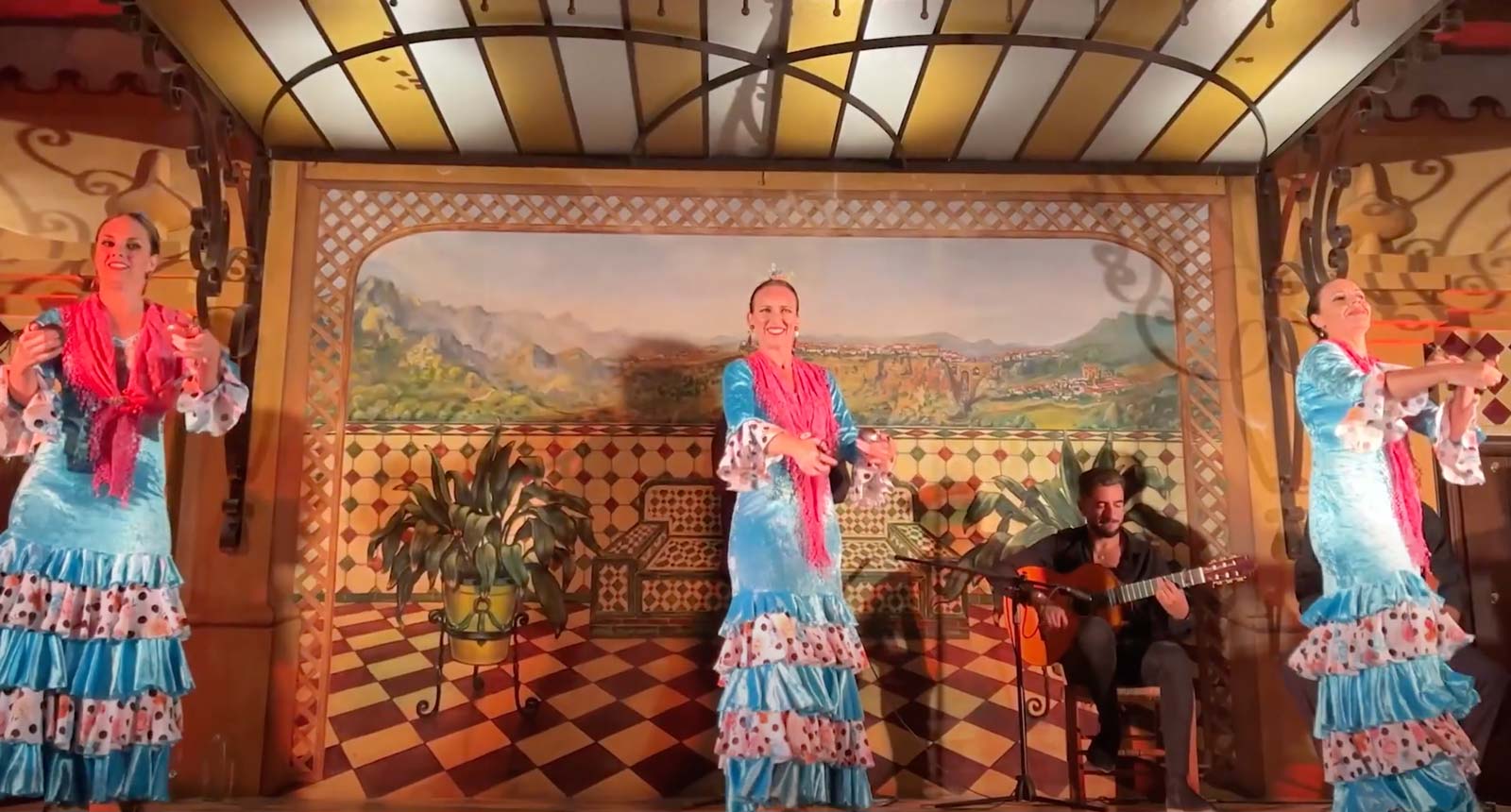
Delve into the soul of Seville with a Flamenco show. The passionate art of Flamenco dancing is rooted in the city’s Gypsy, Moorish, and Jewish traditions, is a must-experience.
Andalucia was the birthplace of Flamenco and seeing a Flamenco performance is a highlight of any trip to Seville. From the intense rhythms of the guitar to the poignant vocals and fervent dance, a Flamenco night is a dive into Andalusian culture.
Book this live Flamenco Show in advance at the Teatro Flamenco Sevilla theater.
La Carbonería
Your average ticket for a flamenco show in Seville will normally cost between 20 and 40€. Instead, why not check out a local flamenco bar that has a free show every night?
Ok, it’s technically not free since you have to pay a 5€ entrance free. However, with that entrance fee, you get a voucher for a free 5€ drink. In my book, that qualifies as free!
The performers go on stage at 10:30PM and put on an amazing show. In my opinion, La Carbonería feels a little more authentic than many of the expensive flamenco shows. Although there are a lot of tourists, there are also plenty of locals.
Hidden within the narrow streets of Seville’s old town, La Carbonería is a cultural beacon. Once a coal yard, it has transformed into one of the city’s most cherished flamenco venues. Free performances almost every night ensure that the spirit of flamenco remains alive and accessible. The rustic interiors, accompanied by heartfelt cante (singing) and passionate dance, make for an unforgettable Andalusian evening.
Barrio Santa Cruz (Santa Cruz Neighborhood)
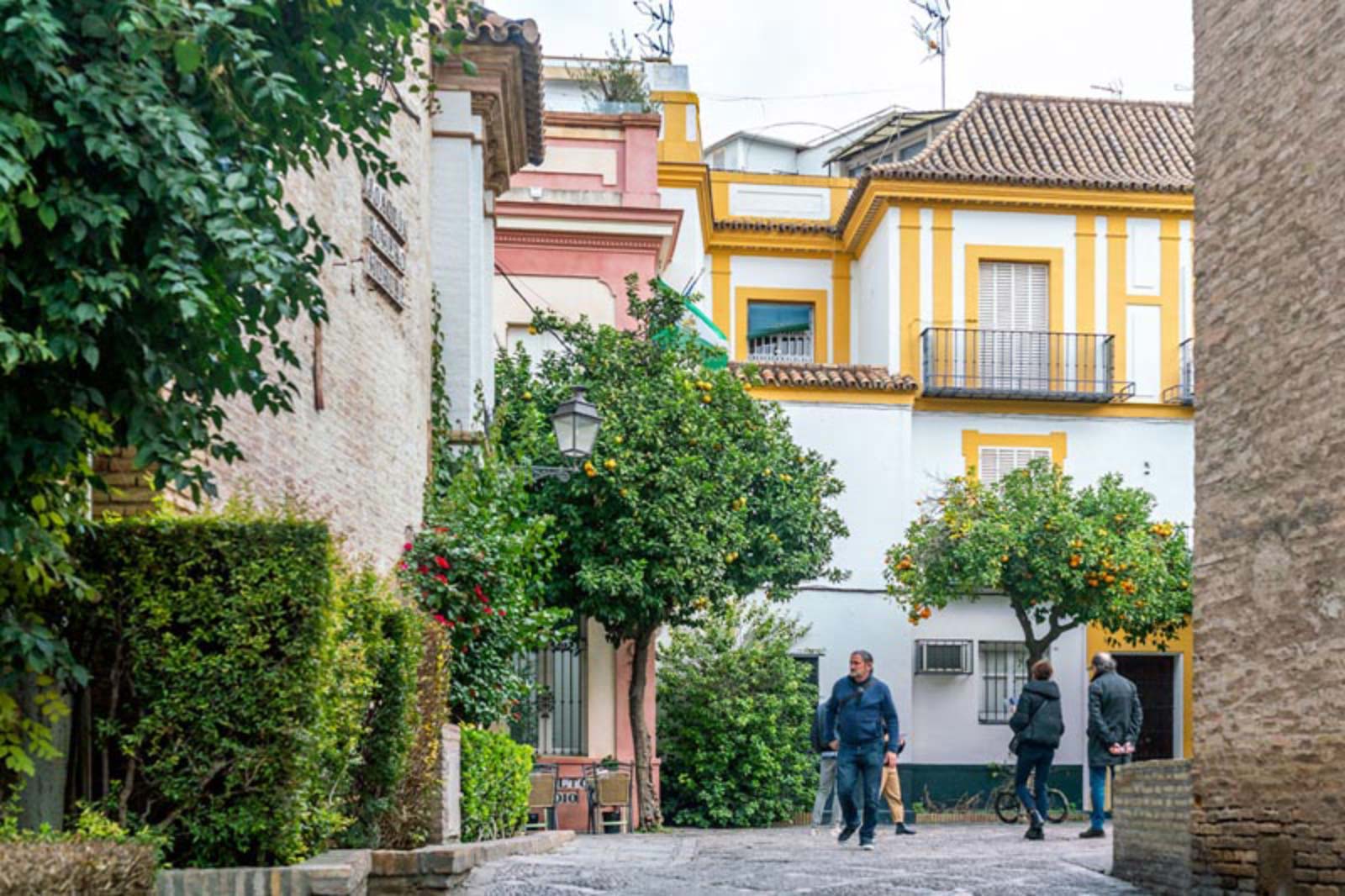
The former Jewish quarter Barrio Santa Cruz is one of Seville’s oldest neighborhoods. Located right next to the cathedral and Alcazar, it’s one of the most picturesque and quaint areas of the city.
Barrio Santa Cruise is full of bars, restaurants, and shops. Although it is a touristy area, it still retains its charm. If it’s your first time visiting Seville, I usually recommend to stay here.
Santa Cruz, the former Jewish quarter of Seville, is a maze of narrow alleys, whitewashed buildings, and hidden plazas. Each turn reveals a new discovery, be it a quaint café, a historic synagogue, or a bustling marketplace. The area resonates with tales of coexistence, love, and intrigue, best experienced with a leisurely walk.
Triana Neighborhood
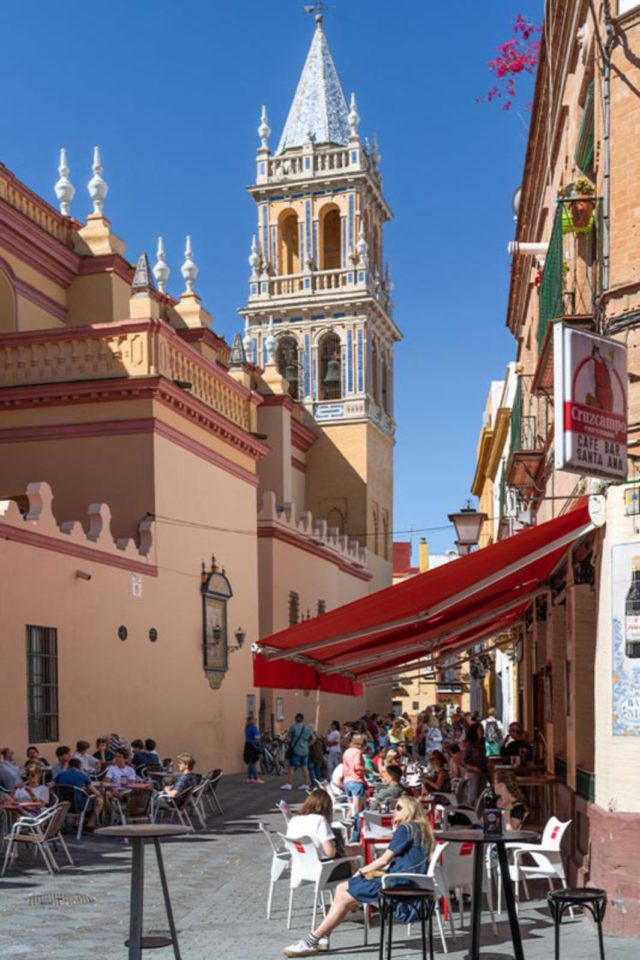
There are a ton of small boutique hotels and even some really nice apartments. Many of the hotels have their own rooftop bars which offer some incredible views of the cathedral and the Giralda Tower.
Triana, straddling the west bank of the Guadalquivir River, is a district that sings of traditional Seville. Known for its vibrant pottery and flamenco roots, this neighborhood has a distinct identity. Its colorful streets, bustling tapas bars, and the iconic Triana Bridge make it a favorite for those seeking an authentic Sevillian experience.
Mercado de Triana
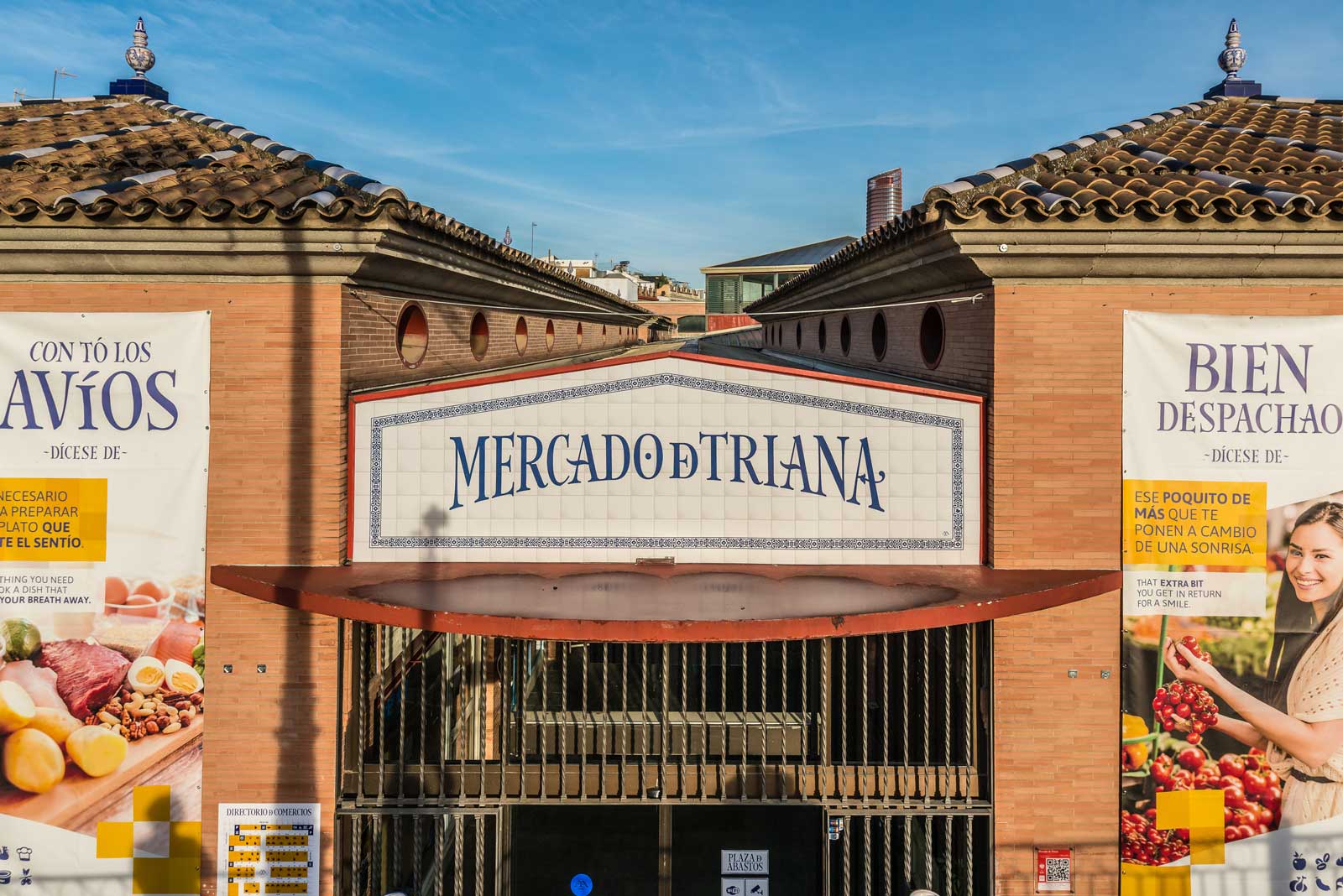
There are two great food markets in Seville, the first is Mercado de Triana. Mercado de Triana is much larger but doesn’t have much in terms of tapas bars, and I suggest visiting both.
Mercado de Triana is located across the iconic Triana bridge lies the Mercado de Triana, a vibrant market that pulses with life. Stalls overflow with fresh produce, seafood, meats, and local specialties. Beyond its culinary offerings, the market stands on the remnants of Castillo de San Jorge, which can still be explored today. It’s a blend of gastronomy and history, appealing to all senses.
Lonja de Feria
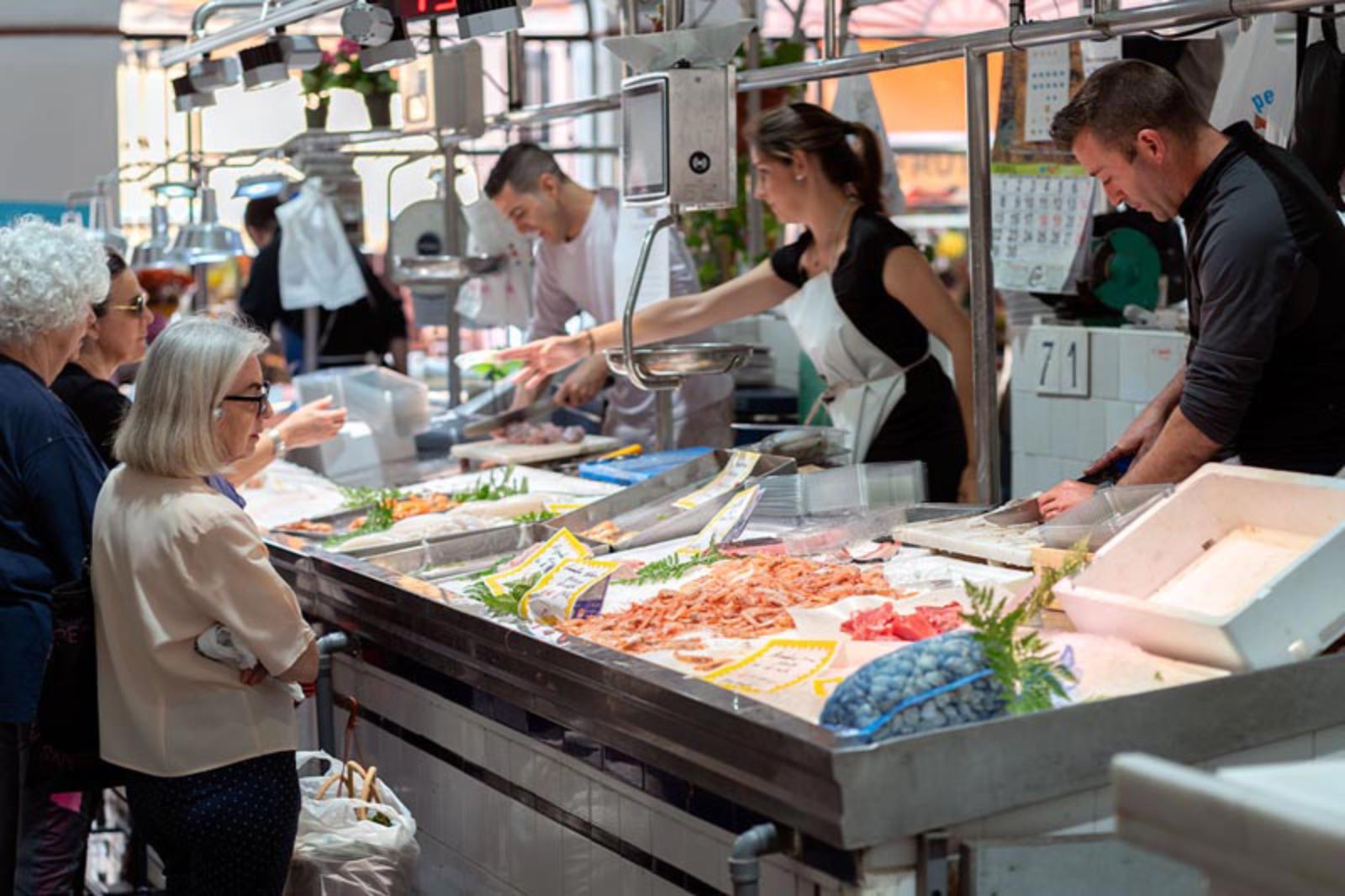
Lonja de Feria is a smaller market but it has a few bars that specialize in fish and seafood that come from the adjacent fishmongers. In any case, both markets showcase a huge variety of fresh local produce, fish, meats, and cheeses.
Lonja de Feria is an emblem of Seville’s gastronomic scene. This market, teeming with local flavors and aromas, allows visitors to savor authentic Andalusian produce, from fresh seafood to artisan cheeses. It’s more than just a food market; it’s a cultural immersion.
Museo De Bellas Artes (Museum of Fine Arts)
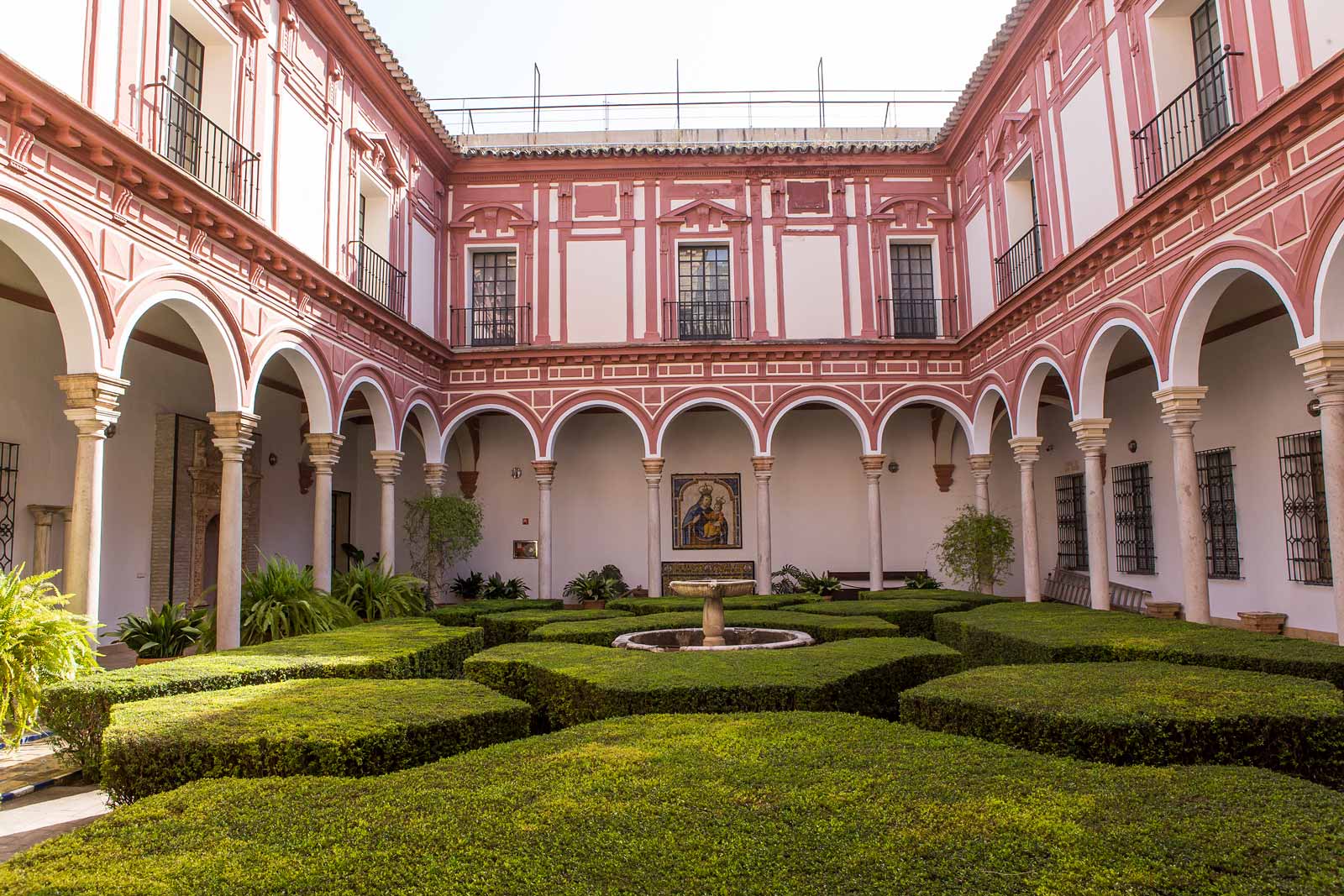
After Madrid’s Prado, Museo de Bellas Artes the Museum of Fine Arts in Seville is considered to have the 2nd most important collection of fine art in the country. For me, the highlights of the museum are the local Andalusian paintings from the 19th century. Nestled in a former monastery, the Museum of Fine Art showcases Seville’s rich artistic lineage.
Housed in a former convent, Seville’s Museum of Fine Art is a haven for art lovers. It boasts a remarkable collection of Spanish art, particularly from the Sevillian School of the Baroque period. Works by Murillo, Zurbarán, and Valdés Leal stand testament to the city’s rich artistic heritage.
However, there are paintings from several famous artists such as Bartolomé Esteban Murillo, Velázquez, Goya and El Greco. In addition, the museum is housed in a 17th century convent that has some beautiful architecture. It is the perfect setting for such a collection of art.
Entrance is free for EU citizens and only 1.5€ for everyone else.
Divino Salvador Church
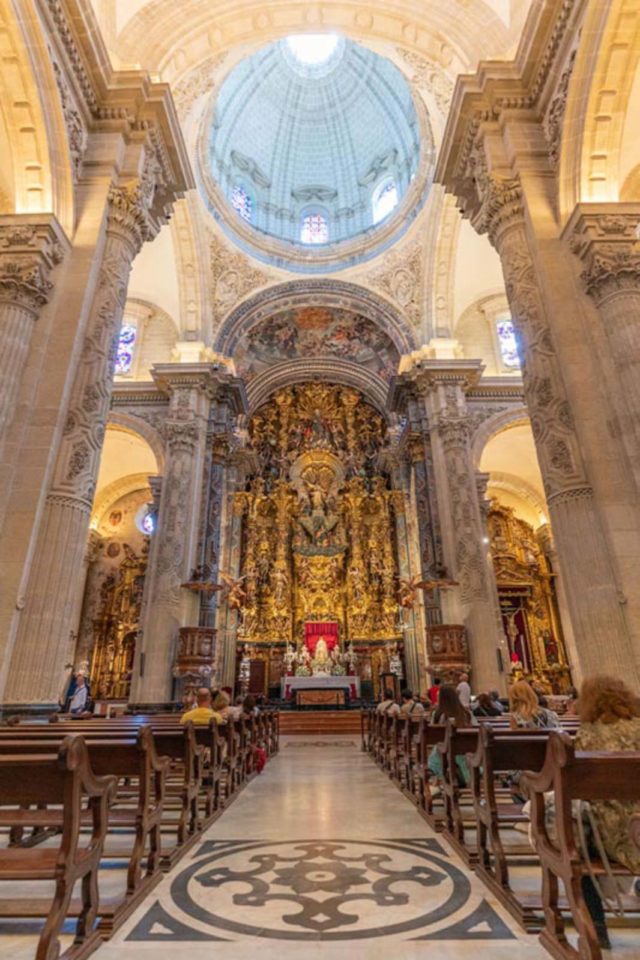
This is Seville’s biggest church after the cathedral. Its history goes back to the 9th century when it was originally the city’s main mosque.
Standing proudly at Plaza del Salvador, this Baroque marvel demands attention. With a façade adorned with sculptures of saints and a lavish interior featuring gilded altarpieces, frescoes, and intricate wooden carvings, the Divino Salvador Church is a testimony to Seville’s grand religious heritage.
It was later rebuilt in an Andalusian Baroque style. If you visit the cathedral and have your ticket from the same day, then the entrance is free. Otherwise, expect to shell out 4€.
The Divino Salvador Church, often overlooked in favor of the grand Seville Cathedral, is an architectural gem in its own right. Originally built on the site of a former mosque, its history spans the Moorish, Gothic, Renaissance, and Baroque periods. The flamboyant Baroque interior dazzles visitors with gilded ornaments, ornate altarpieces, and vivid frescoes.
Archeological Museum
The Archeological Museum is another one of the buildings left over from the world fair in 1929 and it’s located in the Maria Luisa Park. The museum houses the Carambolo Treasure which was discovered in 1958.
It is comprised of gold jewellery and religious relics from the Phoenicians who inhabited parts of Andalusia starting more than 3,000 years ago. The museum is free for EU citizens and only 1.5€ for everyone else.
Nestled within the picturesque Plaza de América, Seville’s Archeological Museum offers a voyage through ancient civilizations that once called this region home. From the Bronze Age to the Roman Empire, its extensive collection includes Roman sculptures, mosaics, and artifacts from the nearby ancient city of Italica. It’s a treasure trove for history enthusiasts keen on understanding the layers beneath contemporary Seville.
Royal Tobacco Factory
The Real Fabrica de Tabacos in the University of Seville dates back to the 18th century. Even though it is a working university, you can still visit and roam its famous halls. It was made famous to the world through the opera Carmen.
Day Trips from Seville
Andalucia has so many amazing places to visit you could spend weeks visiting the surrounding cities, beaches and historic centers. Here are a couple of our favorite day trips.
Granada Day Trip
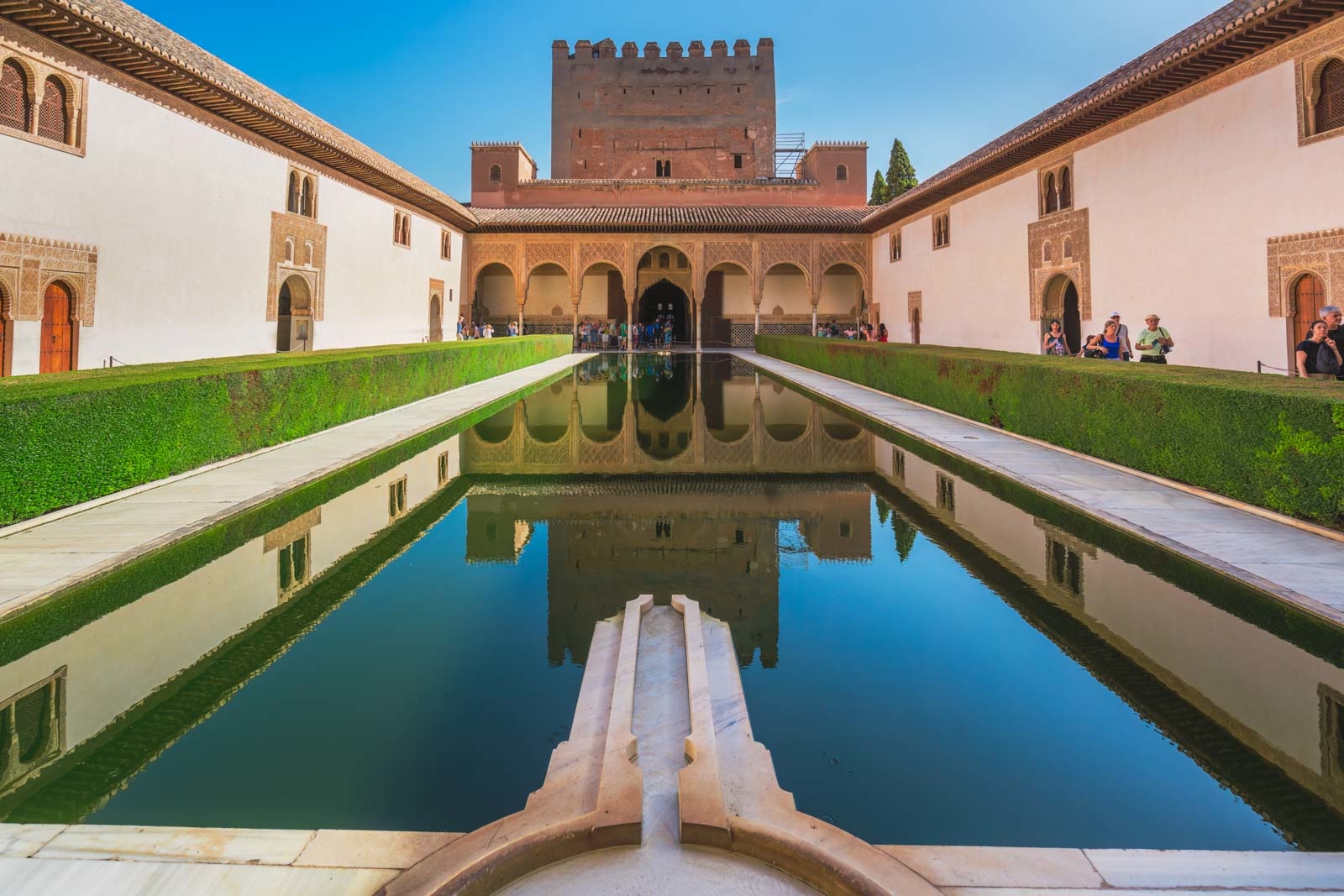
Granada is one of the top cities to visit in Andalucia thanks to its sprawling Alhambra Palace. This is often touted as the crown jewel of Spain. A two and a half hour drive from Seville, Granada attracts visitors from around the world to see Spain’s most iconic monument. Book This Granada day trip from Seville to see Alhambra and Albaicín.
The Alhambra is a sprawling palace-fortress complex that epitomizes Moorish artistry. With its intricate stucco work, elegant courtyards, like the Patio de los Leones, and panoramic views from the Alcazaba fortress, the Alhambra is a masterclass in Islamic architecture and design. Visiting this UNESCO World Heritage site is like stepping back into the grandeur of Al-Andalus.
Granada was the actual birthplace of Flamenco dancing and to see a flamenco show in an authentic cave dwelling is an experience you’ll never forget. Read all about our experience at 26 Best Things to do in Granada, Spain
Cordoba Day Trip
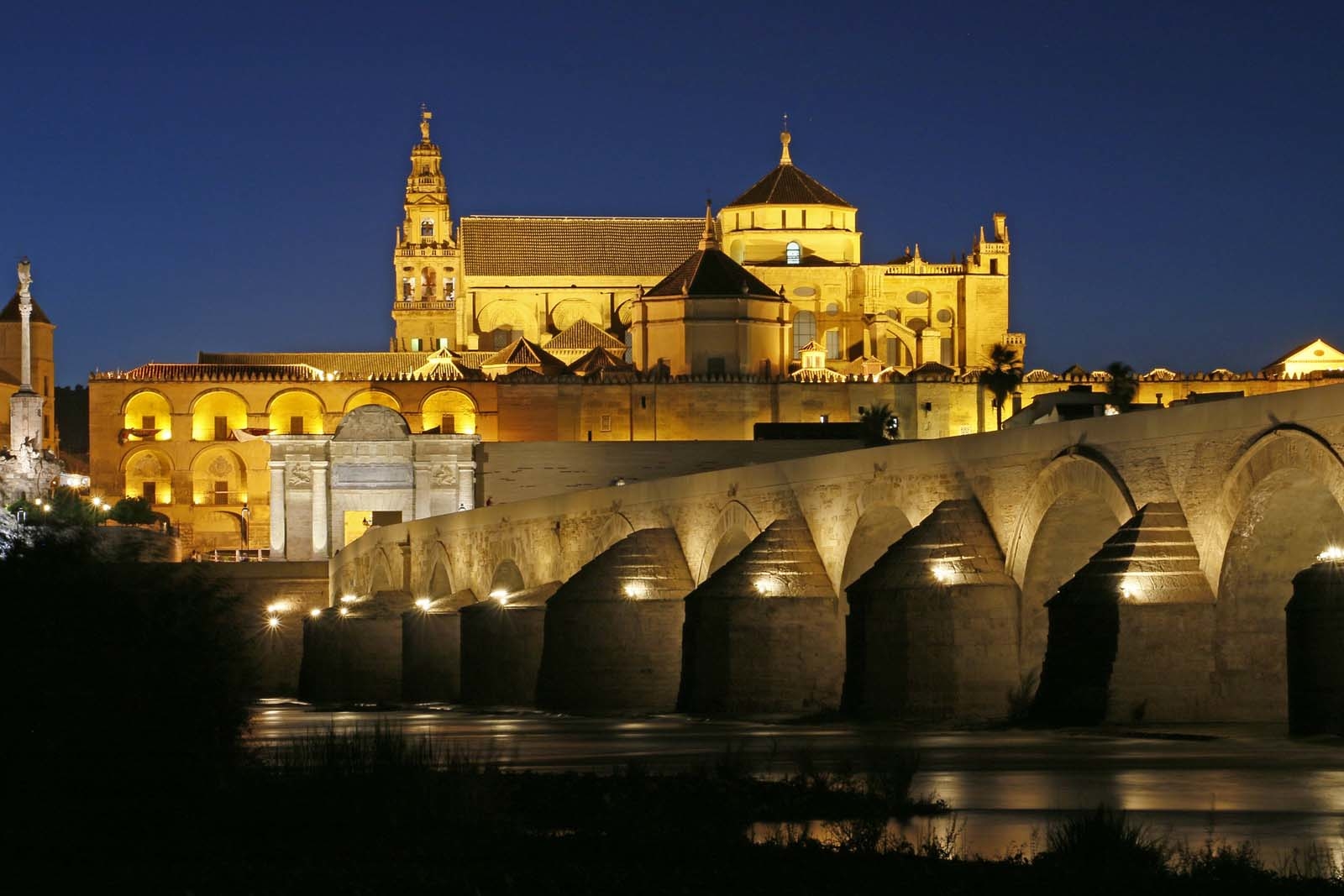
A day trip to Cordoba is popular thanks to the Mosque-Cathedral of Córdoba. The UNESCO World Heritage Site is a testament to the city’s rich tapestry of history. Its origins, architecture, and transformations mirror the changing rulers and religions that have graced Córdoba over the centuries.
Nestled in the heart of Andalusia, Córdoba is a beautiful city where history resonates in every corner, making it an exceptional day trip destination from Seville. Just a short train or car journey away, Córdoba offers an immersive experience into Spain’s deep-rooted heritage and diverse cultures.
The most iconic testament to Córdoba’s historical significance is the Mezquita-Catedral (Mosque-Cathedral). This architectural masterpiece, once a grand mosque and now a cathedral, stands as a symbol of the city’s Islamic and Christian past.
Wander through the narrow cobblestone lanes of Córdoba’s Jewish Quarter or Judería. This ancient neighborhood, with its white-washed walls adorned with colorful flower pots. The historic Synagogue and the Sephardic Museum are notable stops.
Delve into the city’s ancient Roman roots with sites like the impressive Roman Bridge spanning the Guadalquivir River and the remains of the Roman Temple.
Rhonda Day Trip
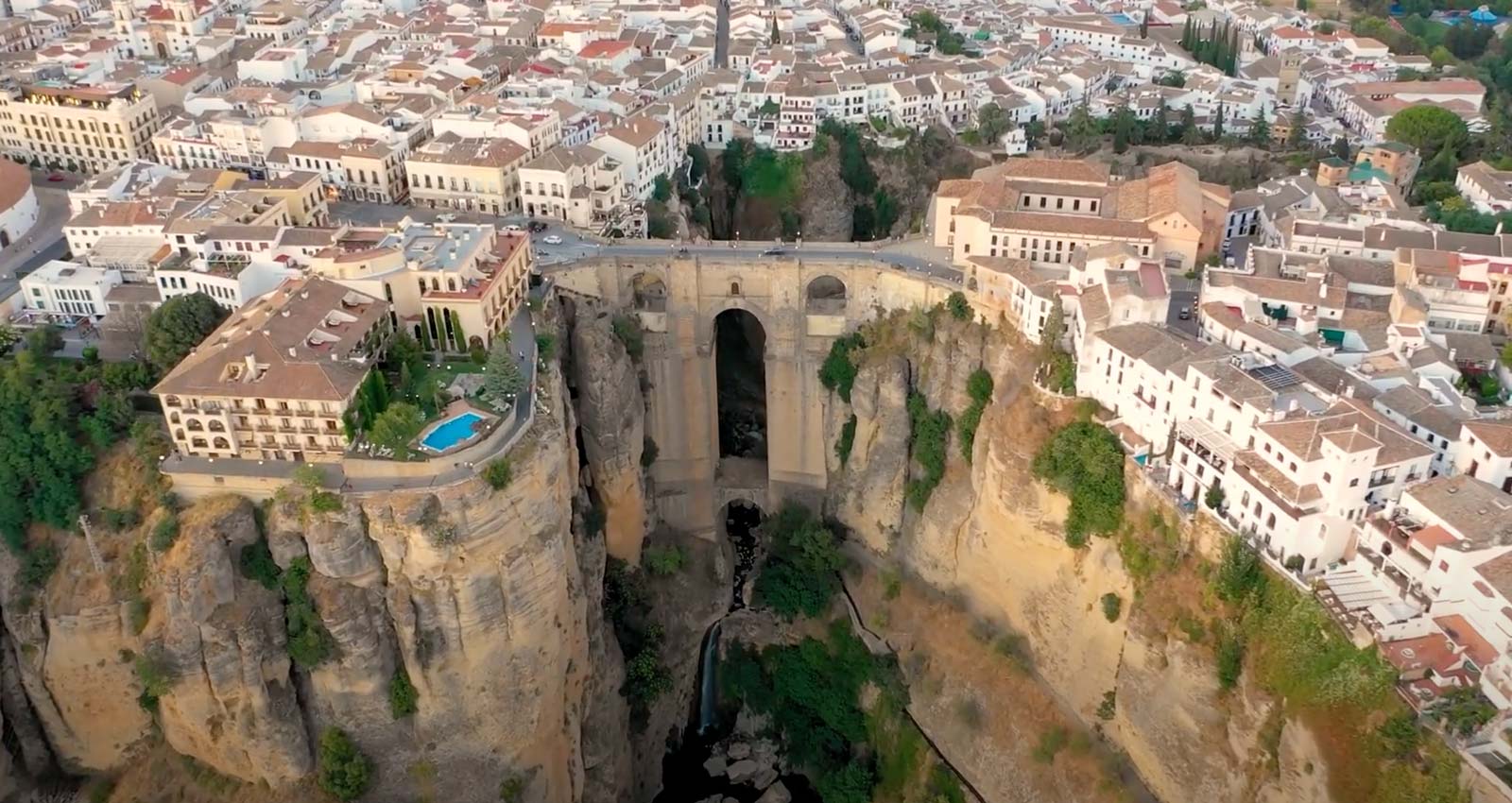
Ronda’s relatively close distance from Seville—around 130 kilometers or about a two-hour drive—makes it a convenient day trip. The journey itself, through rolling hills and olive groves, is scenic and sets the tone for the day ahead. You can book this day trip for a full day guided tour of Ronda and Pueblos Blancos.
Perched atop a towering plateau and bisected by a deep gorge, the picturesque town of Ronda is a hidden gem in Spain’s Andalusia region. While Seville captivates with its historic charm and vibrant culture, a day trip to Ronda offers a contrasting experience, showcasing the region’s natural beauty and intriguing history.
One of Ronda’s most iconic landmarks is the Puente Nuevo, a stone bridge that spans the 100-meter deep El Tajo gorge, connecting the town’s old and new districts. The views from the bridge are nothing short of spectacular, offering panoramic vistas of the Serranía de Ronda mountains and the houses precariously clinging to the cliff’s edge.
Ronda is often credited as the birthplace of modern bullfighting. The Plaza de Toros, one of the oldest and most picturesque bullrings in Spain, offers insights into this deeply traditional Spanish sport. The attached museum provides historical context, showcasing costumes, weapons, and other artifacts.
Browse these best day trips from Seville
How to Get to Seville Spain
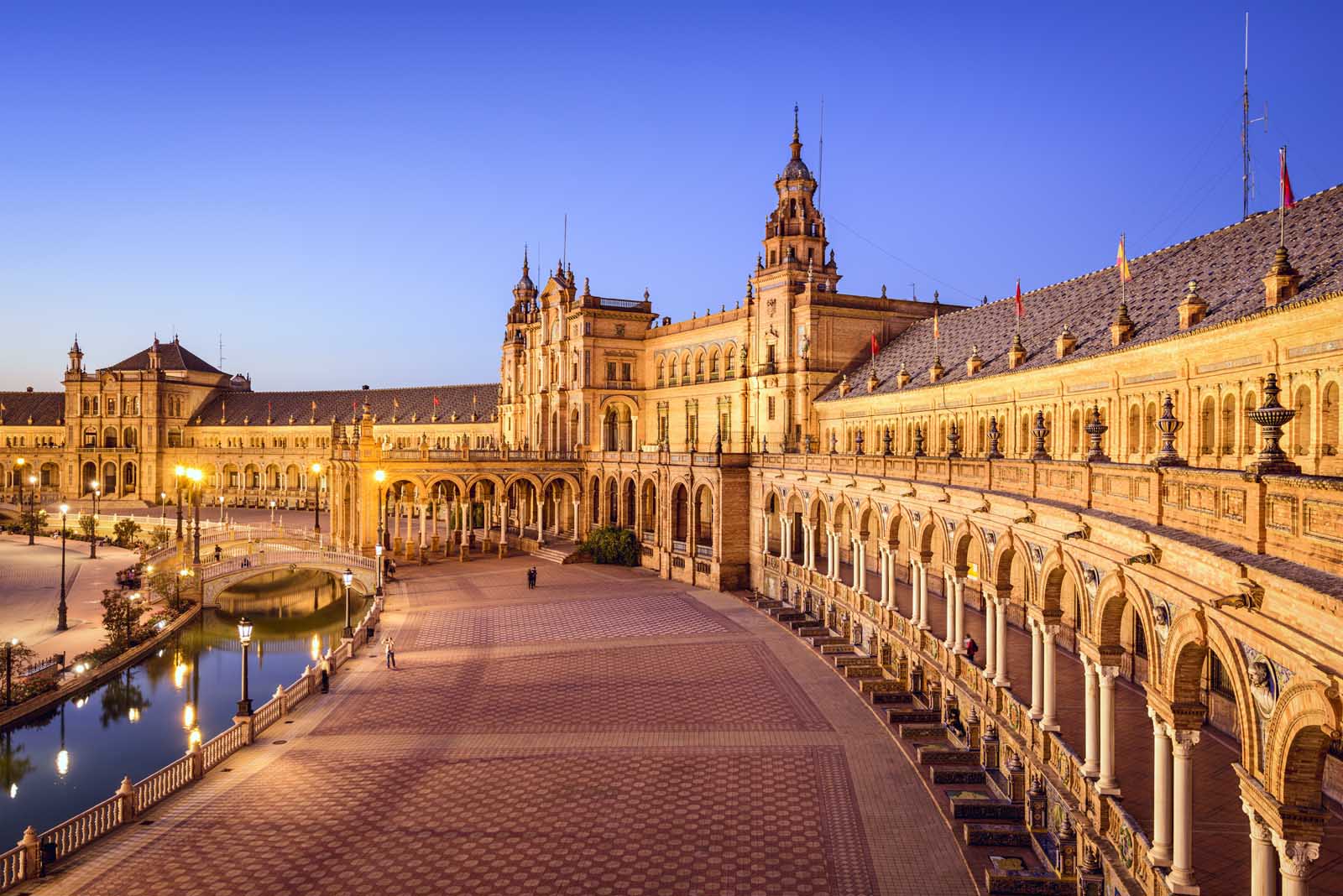
Seville, the capital of Spain’s Andalusia region, is a major city that is well-connected by various means of transportation. Here’s a guide on how to get to Seville:
By Air
Seville Airport (Aeropuerto de Sevilla-San Pablo): Located about 10 km (6 miles) northeast of the city center, this international airport serves several European destinations. Some airlines also offer seasonal flights to non-European destinations.
Transfer to the city: There’s a bus service (EA – Especial Aeropuerto) that connects the airport with the city center, taking around 35 minutes. Alternatively, taxis are available outside the arrivals hall.
By Train
Santa Justa Train Station (Estación de Santa Justa): This is Seville’s main train station and one of Spain’s primary railway hubs. High-speed AVE trains link Seville with major Spanish cities like Madrid (around 2.5 hours), Cordoba (around 45 minutes), and Malaga (around 2 hours).
Transfer to the city: The station is centrally located, so it’s a short taxi or bus ride to most destinations in the city.
By Bus
Seville’s Main Bus Station – Prado de San Sebastián: This station serves regional and some international destinations. Another bus station, Plaza de Armas, caters mostly to long-distance routes.
Transfer to the city: Both bus stations are centrally located, making it easy to get to other parts of Seville by local bus, tram, or taxi.
By Car
If you’re driving to Seville, the city is well-connected by a network of highways. The A-4 highway links Seville with Madrid, while the A-92 connects it with Granada and Malaga. However, do note that driving in the old part of Seville can be challenging due to narrow streets and limited parking.
By Boat
While Seville is inland, it’s connected to the sea by the Guadalquivir River. Some cruise ships make their way up the river to dock in Seville, providing a unique way to arrive in the city.
Once you’re in Seville, it’s relatively easy to navigate. The city boasts an efficient public transportation system, including buses, trams, and a metro. However, many of Seville’s attractions are centrally located, making it a delight to explore on foot or by bicycle.
When is the Best time to Visit Seville, Spain
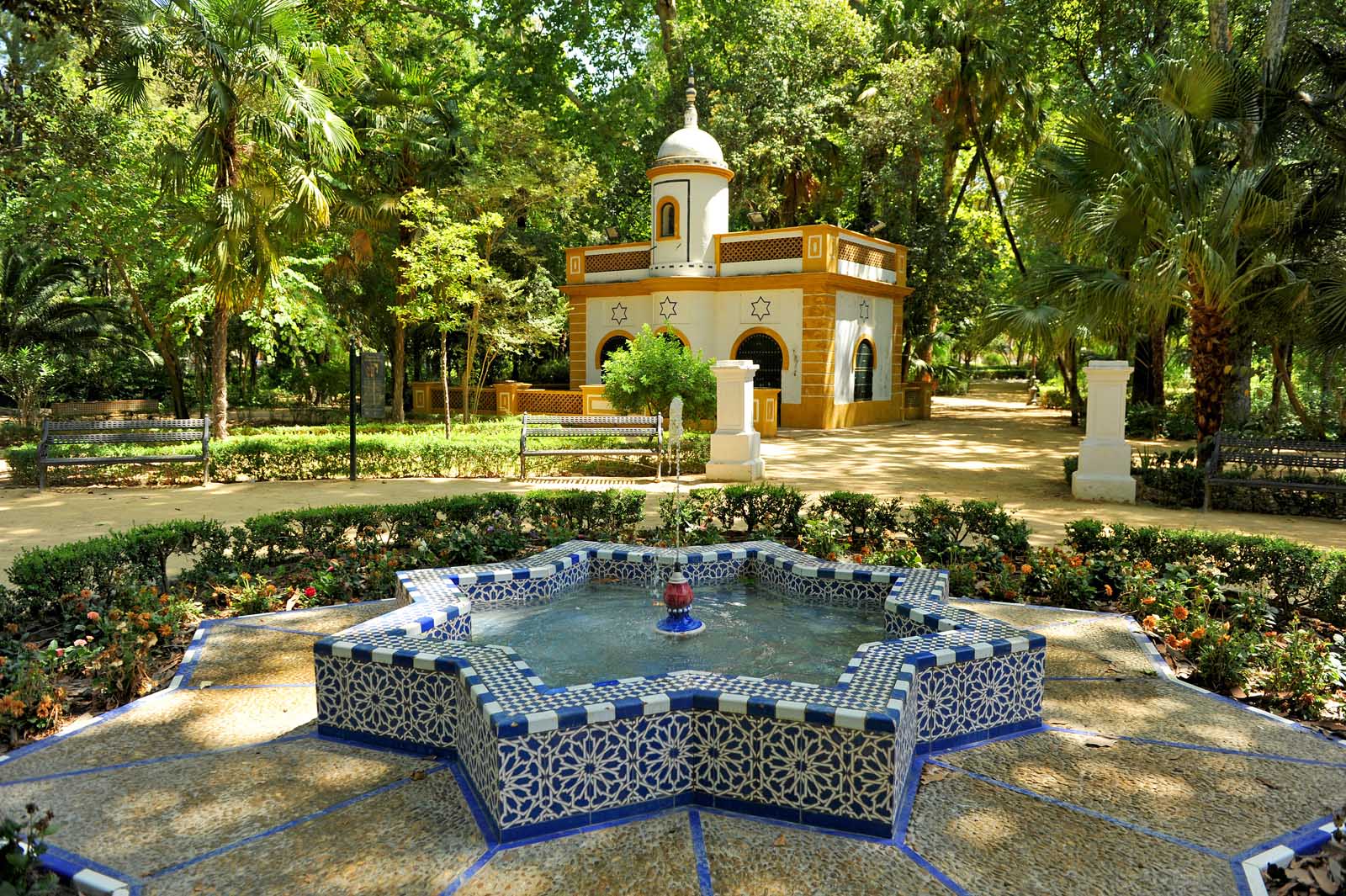
Seville, known for its rich history, vibrant culture, and stunning architecture, also has a distinct climate that varies throughout the year. Determining the best time to visit depends on what you’re seeking, be it pleasant weather, cultural events, or fewer tourists. Here’s a breakdown of the year to help you decide:
Spring (Late March to June):
Weather: Spring is arguably the best time to visit Seville. By late March and April, the chill of winter has subsided, and temperatures are mild and pleasant. May sees slightly warmer days, but it’s still comfortable.
Events: Seville comes alive in spring with two of its most famous events:
Semana Santa (Holy Week): A week-long religious festival with grand processions, traditional costumes, and an atmosphere of deep reverence.
Feria de Abril (April Fair): Usually taking place two weeks after Semana Santa, this is a week of celebration with Sevillanas (traditional dances), colorful dresses, and plenty of partying.
Considerations: These events attract a lot of visitors, so if you plan to attend, book your accommodation well in advance. Also, prices can be higher during this peak season.
Summer (July to September):
Weather: Summers in Seville are hot, with temperatures frequently exceeding 35°C (95°F) and occasionally reaching 40°C (104°F).
Considerations: The intense heat makes sightseeing in the midday sun challenging. However, this is also a quieter time in terms of tourism, and you’ll find fewer crowds at major attractions. If you don’t mind the heat or are seeking a quieter experience, summer can be an option. Just make sure to stay hydrated, wear sunscreen, and plan your outdoor activities for the cooler parts of the day.
Autumn (October to November):
Weather: Autumn brings relief from the summer heat. Temperatures become milder, making it a pleasant time for sightseeing.
Considerations: October can still see a good number of tourists, but by November, things start to quiet down, and you might find better deals on accommodations.
Winter (December to February):
Weather: Winters in Seville are mild compared to many other European cities. Daytime temperatures usually hover around 16°C (60°F), though nights can be cooler.
Considerations: This is the low tourist season, so you’ll find fewer crowds and potentially lower prices on accommodations. While it’s too chilly for beach activities, it’s a great time for exploring the city’s historical sites.
Conclusion: If you’re looking for the best combination of pleasant weather and cultural experiences, spring (particularly April and May) is the ideal time. However, each season offers its own charm and advantages, so consider what’s most important for your trip when deciding on the best time to visit Seville.
Seville Spain Frequently Asked Questions
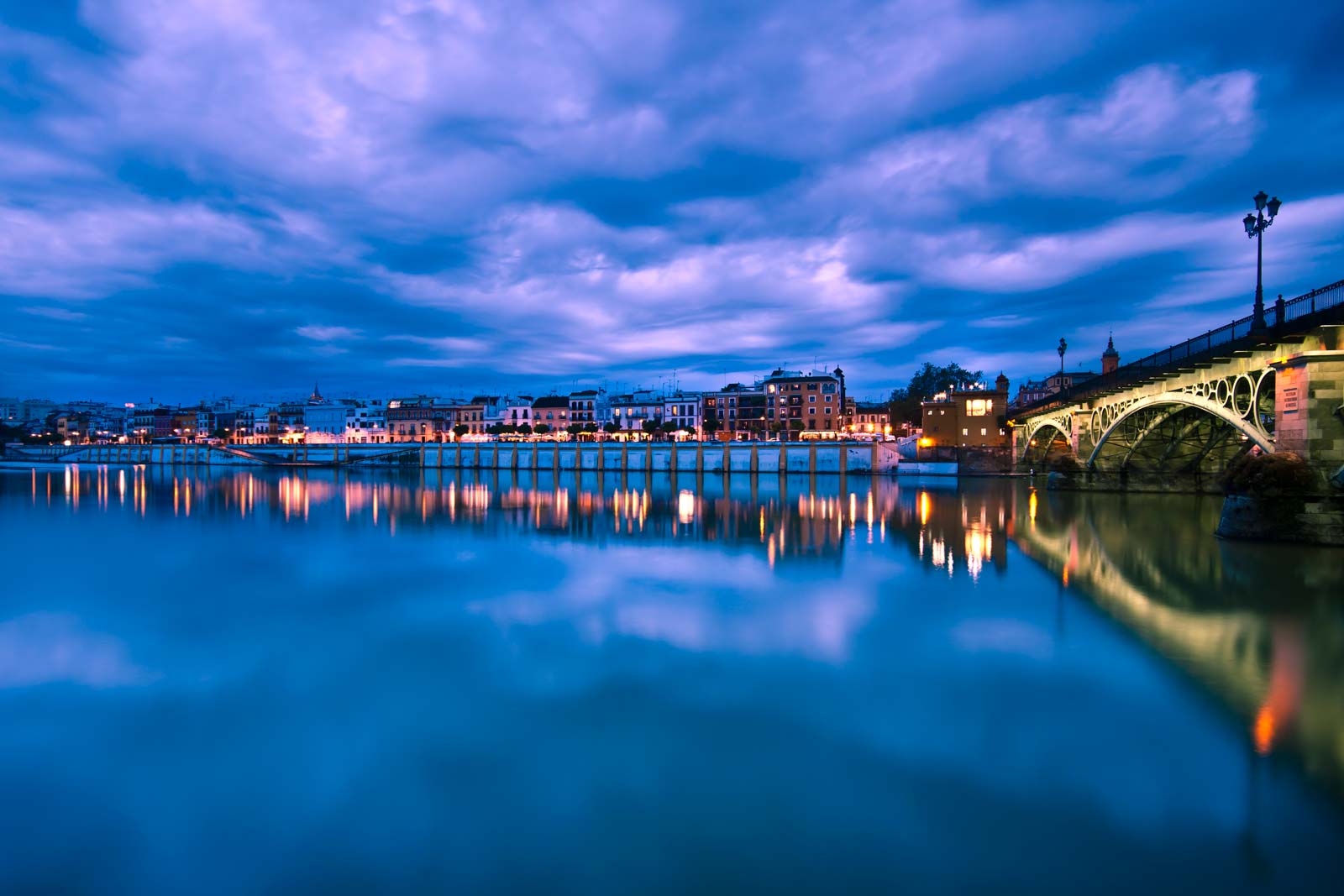
What is the number one attraction in Seville?
The top attractions in Seville are the Plaza de Espana, Real Alcazar, and the Seville Cathedral.
What should you not miss doing in Seville?
You should not miss seeing a Flamenco Performance when in Seville.
What Free Museums can I see in Seville?
Some free museums that you can visit in Seville are the Museum of Fine Arts, The Naval Museum and the Bullfighting Museums of Seville are free on Mondays,
Where is Seville Located
Seville (Sevilla in Spanish) is located in southern Spain. It is the capital and largest city of the province of Seville and the autonomous community of Andalusia. Seville sits on the banks of the Guadalquivir River.
Read more about traveling to Spain
- Romantic Things to Do in Barcelona
- 25 Of The Best Things to Do in Marbella, Spain
- 26 Best Things to Do in Granada, Spain
- 26 of the Best Places to Visit in Barcelona
- 16 of the Best Cities in Spain – Beautiful Places to Visit Right Now
- Camping in Spain: Everything You Need to Know
- Andalusia Travel – 5 Reasons to Visit the South of Spain
- Things to do in Toledo – Beautiful Spanish History Awaits
- Where to Stay in Barcelona

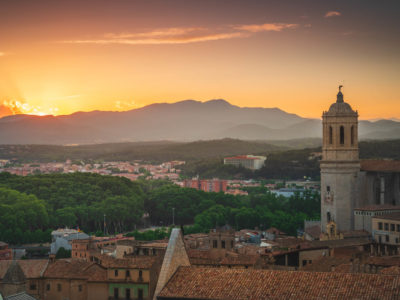
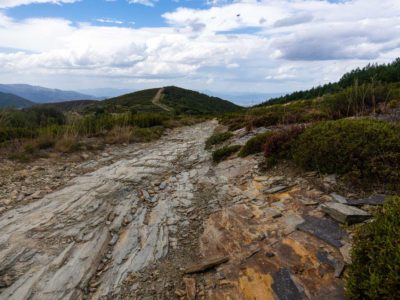
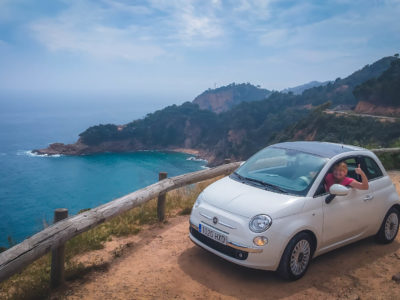
We absolutely love your blog
Oh my, I love Seville! It was so long time since I was there, so I’ve totally forgot how beautiful it is. Wonderful picture. It was in July, and the city had a heat record, so it was well over 40 degrees celsius. Closer to 50 if I remember correctly. I had planned a trip to Spain now in the Autumn, but as it is now I doubt I can realise it this year. Maybe next year, who knows? 🙂
Seville Cathedral is stunning and I think everyone should visit it when exploring this beautiful city. Also, you can opt for a rooftop tour for a few euros extra when you buy a ticket. We were a bit sceptical at first, but it turned out to be one of the coolest experiences!
¡OJO! The archaeology museum is closed for renovations and improvements for at least a year. I’ve lived in Seville for 13 years and have it on my list – still!